Published In: Brief

How to Write a Biography (Examples & Templates)
A biography is a written account of a person’s life that details their life in chronological order. Another person usually writes this detailed account, and it contains reports of their childhood, career, major life events, relationships, and social impact. It also details their relationships with their family, children, and life accomplishments.
The best way to find out more about a popular figure is through reading their biographies, so you need to make sure you get the correct information. Before writing a biography, you need to do a lot of research and interviews to represent a person’s life accurately.
Types of Biography
A biography is the story of someone’s life as written by another writer. Most biographies of popular figures are written years, or even decades, after their deaths. Authors write biographies of popular figures due to either a lack of information on the subject or personal interest.
A biography aims to share a person’s story or highlight a part of their life.
There are different types of biographies, depending on the story. Some biographies are written true to the story, while some are written as fictional works. Biographies can give you true understanding of a person on an internal as well as external level along with a lot of life lessons.
Autobiography
An autobiography is different from a biography because it is written by the subject of the story, themselves. The author writes in the first-person narrative, and it flows step-by-step like a story of their life. Autobiographies contain personal accounts of the subject’s life, along with their perspectives and opinions on events in their life.
How To Write a Biography
Pick a subject.
Picking a subject is the first step in writing a biography. You can pick an already famous person or a relatively unknown person with a great life story. If you already have a few in mind, you can start by asking yourself some questions such as;
- What has the subject accomplished that makes them a good subject?
- Have they had an impact on society?
- Is the subject a celebrity or a well-known personality?
- Will the biography appeal to a wide audience?
Get Permission
When you pick a subject, the next thing to do is to get permission from them or their family or rights owners. Although, with some historical figures, there may not be any need for permission. Getting permission from your subject makes it easier for you to get stories to put into your book. You can get the chance to obtain additional personal stories and anecdotes that will make your book more interesting by doing so as well.
Do The Research
Research is the most important part of a biography’s process as the entire content of the book is dependent on it. Irrespective of what you know about the subject, you need to carry out as much research as possible to get the story’s facts precisely.
Biography research comes from various sources, depending on the book’s subject. Firsthand reports from family, friends, or personal accounts from the subjects are primary sources. They are usually the most accurate and reliable, and they are crucial for a biography. Secondary sources come from other sources like magazines or documentaries.
Pick a Format
Biographies come in various formats, with each of them having their pros and cons. A typical biography will start at the beginning, usually with the birth and childhood of the subject. Yet, if the biography’s theme involves a different event in their life, the author may want to explore the flashback option or one with concurrent events from different times.
Usually, biographies have a theme or a general life lesson at the center. The author’s role is to tell the subject’s story leading up to the major event.
Which-ever format you choose should place the theme at the center, with the other events detailing the journey.
Create a Timeline Of The Story
Since a biography takes place in chronological order, there needs to be a timeline of the events in the right order. The timeline should contain the key events in the subject’s life, in the order the author plans on revealing them. A great way to declutter the story and keep it interesting is to use flashbacks . This way, the author can introduce past events and explain later events excluding the element of monotony.
Add In Your Thoughts
The good thing about biographies is that you don’t have to stick to the hard facts only. As the author, you can share your opinions and emotions in writing. The author has the freedom to do this by commenting on a significant action by the subject in a manner that describes why they feel the subject may have done what they did.
The author can also include commentary on events depicted in the biography – how it was influenced society or its impact on the lives around them. Recounting these events through a different perspective can make the biography more relatable and interesting to read.
FAQ’s
Why is a biography template important.
A biography template has an outline that makes the writing easier for the author. Biography templates usually contain a sample timeline, format, and questions that provide more information about the subject. With a great biography template, you can cut your writing time in half and spend less time coming up with an outline.
How are biographies better in comparison to autobiographies
Since a different person writes biographies, they tend to be more objective and somewhat accurate than autobiographies. An autobiography tells things from the author’s perspective, so their views and perspective cloud it. Thus, a biography will likely tell a more factual story.
These are the important steps you need to take to help you write a great biography. Now, to make things easier for you, we have a free customizable autobiography and biography template that you can use to start your first book. Get the template and start writing today
What are some of the most important elements to keep in consideration while writing a biography?
Any author looking to write a biography must consider the factors below. They aren’t the only important factors, but a biography isn’t complete without them. • Date and place of their birth • Academic background • Professional expertise • Death, if deceased • Facts and anecdotes about the person • Main accomplishments • Detailed accounts of their child and adult life
Biographies tell the untold stories of some incredibly relevant people in the world. But biographies are not always strictly accurate. So, every biographer needs to follow the necessary steps to provide a biography with all the requirements.
Related Documents
Looking to publish? Meet your dream editor, designer and marketer on Reedsy.
Find the perfect editor for your next book
1 million authors trust the professionals on Reedsy. Come meet them.
Blog • Perfecting your Craft
Posted on Jun 30, 2023
How to Write a Biography: A 7-Step Guide [+Template]
From time to time, nonfiction authors become so captivated by a particular figure from either the present or the past, that they feel compelled to write an entire book about their life. Whether casting them as heroes or villains, there is an interesting quality in their humanity that compels these authors to revisit their life paths and write their story.
However, portraying someone’s life on paper in a comprehensive and engaging way requires solid preparation. If you’re looking to write a biography yourself, in this post we’ll share a step-by-step blueprint that you can follow.
How to write a biography:
1. Seek permission when possible
2. research your subject thoroughly, 3. do interviews and visit locations, 4. organize your findings, 5. identify a central thesis, 6. write it using narrative elements, 7. get feedback and polish the text.

FREE RESOURCE
Biography Outline Template
Craft a satisfying story arc for your biography with our free template.
While you technically don’t need permission to write about public figures (or deceased ones), that doesn't guarantee their legal team won't pursue legal action against you. Author Kitty Kelley was sued by Frank Sinatra before she even started to write His Way , a biography that paints Ol Blue Eyes in a controversial light. (Kelley ended up winning the lawsuit, however).

Whenever feasible, advise the subject’s representatives of your intentions. If all goes according to plan, you’ll get a green light to proceed, or potentially an offer to collaborate. It's a matter of common sense; if someone were to write a book about you, you would likely want to know about it well prior to publication. So, make a sincere effort to reach out to their PR staff to negotiate an agreement or at least a mutual understanding of the scope of your project.
At the same time, make sure that you still retain editorial control over the project, and not end up writing a puff piece that treats its protagonist like a saint or hero. No biography can ever be entirely objective, but you should always strive for a portrayal that closely aligns with facts and reality.
If you can’t get an answer from your subject, or you’re asked not to proceed forward, you can still accept the potential repercussions and write an unauthorized biography . The “rebellious act” of publishing without consent indeed makes for great marketing, though it’ll likely bring more headaches with it too.
✋ Please note that, like other nonfiction books, if you intend to release your biography with a publishing house , you can put together a book proposal to send to them before you even write the book. If they like it enough, they might pay you an advance to write it.

Book Proposal Template
Craft a professional pitch for your nonfiction book with our handy template.
Once you’ve settled (or not) the permission part, it’s time to dive deep into your character’s story.
Deep and thorough research skills are the cornerstone of every biographer worth their salt. To paint a vivid and accurate portrait of someone's life, you’ll have to gather qualitative information from a wide range of reliable sources.
Start with the information already available, from books on your subject to archival documents, then collect new ones firsthand by interviewing people or traveling to locations.
Browse the web and library archives

Put your researcher hat on and start consuming any piece on your subject you can find, from their Wikipedia page to news articles, interviews, TV and radio appearances, YouTube videos, podcasts, books, magazines, and any other media outlets they may have been featured in.
Establish a system to orderly collect the information you find 一 even seemingly insignificant details can prove valuable during the writing process, so be sure to save them.
Depending on their era, you may find most of the information readily available online, or you may need to search through university libraries for older references.

For his landmark biography of Alexander Hamilton, Ron Chernow spent untold hours at Columbia University’s library , reading through the Hamilton family papers, visiting the New York Historical Society, as well as interviewing the archivist of the New York Stock Exchange, and so on. The research process took years, but it certainly paid off. Chernow discovered that Hamilton created the first five securities originally traded on Wall Street. This finding, among others, revealed his significant contributions to shaping the current American financial and political systems, a legacy previously often overshadowed by other founding fathers. Today Alexander Hamilton is one of the best-selling biographies of all time, and it has become a cultural phenomenon with its own dedicated musical.
Besides reading documents about your subject, research can help you understand the world that your subject lived in.
Try to understand their time and social environment
Many biographies show how their protagonists have had a profound impact on society through their philosophical, artistic, or scientific contributions. But at the same time, it’s worth it as a biographer to make an effort to understand how their societal and historical context influenced their life’s path and work.
An interesting example is Stephen Greenblatt’s Will in the World . Finding himself limited by a lack of verified detail surrounding William Shakespeare's personal life, Greenblatt, instead, employs literary interpretation and imaginative reenactments to transport readers back to the Elizabethan era. The result is a vivid (though speculative) depiction of the playwright's life, enriching our understanding of his world.

Many readers enjoy biographies that transport them to a time and place, so exploring a historical period through the lens of a character can be entertaining in its own right. The Diary of Samuel Pepys became a classic not because people were enthralled by his life as an administrator, but rather from his meticulous and vivid documentation of everyday existence during the Restoration period.
Once you’ve gotten your hands on as many secondary sources as you can find, you’ll want to go hunting for stories first-hand from people who are (or were) close to your subject.
With all the material you’ve been through, by now you should already have a pretty good picture of your protagonist. But you’ll surely have some curiosities and missing dots in their character arc to figure out, which you can only get by interviewing primary sources.
Interview friends and associates
This part is more relevant if your subject is contemporary, and you can actually meet up or call with relatives, friends, colleagues, business partners, neighbors, or any other person related to them.
In writing the popular biography of Steve Jobs, Walter Isaacson interviewed more than one hundred people, including Jobs’s family, colleagues, former college mates, business rivals, and the man himself.
🔍 Read other biographies to get a sense of what makes a great one. Check out our list of the 30 best biographies of all time , or take our 30-second quiz below for tips on which one you should read next.
Which biography should you read next?
Discover the perfect biography for you. Takes 30 seconds!
When you conduct your interviews, make sure to record them with high quality audio you can revisit later. Then use tools like Otter.ai or Descript to transcribe them 一 it’ll save you countless hours.
You can approach the interview with a specific set of questions, or follow your curiosity blindly, trying to uncover revealing stories and anecdotes about your subject. Whatever your method, author and biography editor Tom Bromley suggests that every interviewer arrives prepared, "Show that you’ve done your work. This will help to put the interviewee at ease, and get their best answers.”
Bromley also places emphasis on the order in which you conduct interviews. “You may want to interview different members of the family or friends first, to get their perspective on something, and then go directly to the main interviewee. You'll be able to use that knowledge to ask sharper, more specific questions.”
Finally, consider how much time you have with each interviewee. If you only have a 30-minute phone call with an important person, make it count by asking directly the most pressing questions you have. And, if you find a reliable source who is also particularly willing to help, conduct several interviews and ask them, if appropriate, to write a foreword as part of the book’s front matter .
Sometimes an important part of the process is packing your bags, getting on a plane, and personally visiting significant places in your character’s journey.
Visit significant places in their life
A place, whether that’s a city, a rural house, or a bodhi tree, can carry a particular energy that you can only truly experience by being there. In putting the pieces together about someone’s life, it may be useful to go visit where they grew up, or where other significant events of their lives happened. It will be easier to imagine what they experienced, and better tell their story.
In researching The Lost City of Z , author David Grann embarked on a trek through the Amazon, retracing the steps of British explorer Percy Fawcett. This led Grann to develop new theories about the circumstances surrounding the explorer's disappearance.

Hopefully, you won’t have to deal with jaguars and anacondas to better understand your subject’s environment, but try to walk into their shoes as much as possible.
Once you’ve researched your character enough, it’s time to put together all the puzzle pieces you collected so far.
Take the bulk of notes, media, and other documents you’ve collected, and start to give them some order and structure. A simple way to do this is by creating a timeline.
Create a chronological timeline
It helps to organize your notes chronologically 一 from childhood to the senior years, line up the most significant events of your subject’s life, including dates, places, names and other relevant bits.

You should be able to divide their life into distinct periods, each with their unique events and significance. Based on that, you can start drafting an outline of the narrative you want to create.
Draft a story outline
Since a biography entails writing about a person’s entire life, it will have a beginning, a middle, and an end. You can pick where you want to end the story, depending on how consequential the last years of your subject were. But the nature of the work will give you a starting character arc to work with.
To outline the story then, you could turn to the popular Three-Act Structure , which divides the narrative in three main parts. In a nutshell, you’ll want to make sure to have the following:
- Act 1. Setup : Introduce the protagonist's background and the turning points that set them on a path to achieve a goal.
- Act 2. Confrontation : Describe the challenges they encounter, both internal and external, and how they rise to them. Then..
- Act 3. Resolution : Reach a climactic point in their story in which they succeed (or fail), showing how they (and the world around them) have changed as a result.
Only one question remains before you begin writing: what will be the main focus of your biography?
Think about why you’re so drawn to your subject to dedicate years of your life to recounting their own. What aspect of their life do you want to highlight? Is it their evil nature, artistic genius, or visionary mindset? And what evidence have you got to back that up? Find a central thesis or focus to weave as the main thread throughout your narrative.

Or find a unique angle
If you don’t have a particular theme to explore, finding a distinct angle on your subject’s story can also help you distinguish your work from other biographies or existing works on the same subject.
Plenty of biographies have been published about The Beatles 一 many of which have different focuses and approaches:
- Philip Norman's Shout is sometimes regarded as leaning more towards a pro-Lennon and anti-McCartney stance, offering insights into the band's inner dynamics.
- Ian McDonald's Revolution in the Head closely examines their music track by track, shifting the focus back to McCartney as a primary creative force.
- Craig Brown's One Two Three Four aims to capture their story through anecdotes, fan letters, diary entries, and interviews.
- Mark Lewisohn's monumental three-volume biography, Tune In , stands as a testament to over a decade of meticulous research, chronicling every intricate detail of the Beatles' journey.

Finally, consider that biographies are often more than recounting the life of a person. Similar to how Dickens’ Great Expectations is not solely about a boy named Pip (but an examination and critique of Britain’s fickle, unforgiving class system), a biography should strive to illuminate a broader truth — be it social, political, or human — beyond the immediate subject of the book.
Once you’ve identified your main focus or angle, it’s time to write a great story.

While biographies are often highly informative, they do not have to be dry and purely expository in nature . You can play with storytelling elements to make it an engaging read.
You could do that by thoroughly detailing the setting of the story , depicting the people involved in the story as fully-fledged characters , or using rising action and building to a climax when describing a particularly significant milestone of the subject’s life.
One common way to make a biography interesting to read is starting on a strong foot…
Hook the reader from the start
Just because you're honoring your character's whole life doesn't mean you have to begin when they said their first word. Starting from the middle or end of their life can be more captivating as it introduces conflicts and stakes that shaped their journey.
When he wrote about Christopher McCandless in Into the Wild , author Jon Krakauer didn’t open his subject’s childhood and abusive family environment. Instead, the book begins with McCandless hitchhiking his way into the wilderness, and subsequently being discovered dead in an abandoned bus. By starting in medias res , Krakauer hooks the reader’s interest, before tracing back the causes and motivations that led McCandless to die alone in that bus in the first place.

You can bend the timeline to improve the reader’s reading experience throughout the rest of the story too…
Play with flashback
While biographies tend to follow a chronological narrative, you can use flashbacks to tell brief stories or anecdotes when appropriate. For example, if you were telling the story of footballer Lionel Messi, before the climax of winning the World Cup with Argentina, you could recall when he was just 13 years old, giving an interview to a local newspaper, expressing his lifelong dream of playing for the national team.
Used sparsely and intentionally, flashbacks can add more context to the story and keep the narrative interesting. Just like including dialogue does…
Reimagine conversations
Recreating conversations that your subject had with people around them is another effective way to color the story. Dialogue helps the reader imagine the story like a movie, providing a deeper sensory experience.

One thing is trying to articulate the root of Steve Jobs’ obsession with product design, another would be to quote his father , teaching him how to build a fence when he was young: “You've got to make the back of the fence just as good looking as the front of the fence. Even though nobody will see it, you will know. And that will show that you're dedicated to making something perfect.”
Unlike memoirs and autobiographies, in which the author tells the story from their personal viewpoint and enjoys greater freedom to recall conversations, biographies require a commitment to facts. So, when recreating dialogue, try to quote directly from reliable sources like personal diaries, emails, and text messages. You could also use your interview scripts as an alternative to dialogue. As Tom Bromley suggests, “If you talk with a good amount of people, you can try to tell the story from their perspective, interweaving different segments and quoting the interviewees directly.”

FREE COURSE
How to Write Believable Dialogue
Master the art of dialogue in 10 five-minute lessons.
These are just some of the story elements you can use to make your biography more compelling. Once you’ve finished your manuscript, it’s a good idea to ask for feedback.
If you’re going to self-publish your biography, you’ll have to polish it to professional standards. After leaving your work to rest for a while, look at it with fresh eyes and self-edit your manuscript eliminating passive voice, filler words, and redundant adverbs.

Then, have a professional editor give you a general assessment. They’ll look at the structure and shape of your manuscript and tell you which parts need to be expanded on or cut. As someone who edited and commissioned several biographies, Tom Bromley points out that a professional “will look at the sources used and assess whether they back up the points made, or if more are needed. They would also look for context, and whether or not more background information is needed for the reader to understand the story fully. And they might check your facts, too.”
In addition to structural editing, you may want to have someone copy-edit and proofread your work.

MEET EDITORS
Polish your book with expert help
Sign up, meet 1500+ experienced editors, and find your perfect match.
Importantly, make sure to include a bibliography with a list of all the interviews, documents, and sources used in the writing process. You’ll have to compile it according to a manual of style, but you can easily create one by using tools like EasyBib . Once the text is nicely polished and typeset in your writing software , you can prepare for the publication process.
In conclusion, by mixing storytelling elements with diligent research, you’ll be able to breathe life into a powerful biography that immerses readers in another individual’s life experience. Whether that’ll spark inspiration or controversy, remember you could have an important role in shaping their legacy 一 and that’s something not to take lightly.
Continue reading
Recommended posts from the Reedsy Blog

How Many Sentences Are in a Paragraph?
From fiction to nonfiction works, the length of a paragraph varies depending on its purpose. Here's everything you need to know.

Narrative Structure: Definition, Examples, and Writing Tips
What's the difference between story structure and narrative structure? And how do you choose the right narrative structure for you novel?

What is the Proust Questionnaire? 22 Questions to Write Better Characters
Inspired by Marcel Proust, check out the questionnaire that will help your characters remember things past.

What is Pathos? Definition and Examples in Literature
Pathos is a literary device that uses language to evoke an emotional response, typically to connect readers with the characters in a story.

How to Start a Children’s Book: Coming Up with Your Big Idea
If you've ever dreamed of writing a children's book but aren't sure where to start, check out this post to learn more about how you can create the perfect story for kids.

How to Become a Travel Writer in 5 Steps: A Guide for Travel Bugs
If you want to get paid to share your adventures, learn how to become a travel writer with these five tips.
Join a community of over 1 million authors
Reedsy is more than just a blog. Become a member today to discover how we can help you publish a beautiful book.

We made a writing app for you
Yes, you! Write. Format. Export for ebook and print. 100% free, always.

1 million authors trust the professionals on Reedsy. Come meet them.
Enter your email or get started with a social account:
How to Write a Biography
Learn how to write a biography with our comprehensive guide.

Last updated on Dec 8th, 2023

When you click on affiliate links on QuillMuse.com and make a purchase, you won’t pay a penny more, but we’ll get a small commission—this helps us keep up with publishing valuable content on QuillMuse. Read More .
Table of Contents
How to write a biography can be a fun challenge as you share someone’s life story with readers. You may need to write a biography for a class or decide to write a biography as a personal project. Once you’ve identified the subject of your biography, do your research to learn as much as you can about them. Then, immerse yourself in writing the biography and revising it until it’s best. What I am going to share with you in today’s post is how to write a biography. If you want to know the rules of how to write a biography correctly then this post of ours is essential for you.
Introduction
While it’s true that most biographies involve people in the public eye, sometimes the subject is less well-known. But most of the time, famous or not, the person we’re talking about has an incredible life. Although your students may have a basic understanding of How to write a biography, you should take some time before putting pen to paper to come up with a very clear definition of biography.
Before knowing how to write a biography, let’s first understand what a biography is. A biography is an account of a person’s life written by someone else. Although there is a genre called fictional biography, by definition biographies are mostly non-fiction. In general, biographies trace the subject’s life from early childhood to the present day or until death if the subject is deceased.
Biography writing is not limited to describing the bare facts of a person’s life. Instead of just listing basic details about their upbringing, interests, education, work, relationships, and deaths, a well-written biography should also paint a picture of a person’s personality as well as that person’s life experiences.
Tips and Tricks For How To Write a Biography
1. ask the subject’s permission to write a biography.
Here are the first tips on how to write a biography. Before starting your research, make sure you get your subject’s consent to write their biography. Ask them if they’re ready to be the subject. Getting their permission will make writing a biography much easier and ensure that they are open to information about their lives.
If the theme does not allow you to write a bio, you can choose another theme. If you decide to publish a profile without the subject’s permission, you may be subject to legal action from the subject.
If the topic no longer exists, you don’t need to ask permission to write about them.
2. Research primary sources on the topic
Primary sources may include books, letters, photographs, diaries, newspaper clippings, magazines, Internet articles, magazines, videos, interviews, existing biographies, or autobiographies on the subject. Find these resources in your local library or online. Read as much as you can about the topic and highlight any important information you come across in your sources.
You can create research questions to help you focus your research on this topic, such as:
What do I find interesting about this topic? Why is this topic important to readers?
3. Conduct interviews with subjects and their relatives
Interviewing people will turn your research into reality: the people you interview will be able to tell you stories you can’t find in history books. Interview the subject as well as people close to them, such as spouses, friends, business associates, family members, co-workers, and friends. Interview in person, over the phone, or via email.
For in-person interviews, record them with a voice recorder or voice recorder on your computer or phone. You may need to interview the subject and others multiple times to get the documents you need.
4. Visit places important to the topic
Whenever you want to know how to write a biography, to understand the history of the subject, spend time in places and areas that are significant to the subject. This may be the subject’s childhood home or neighborhood. You can also visit the subject’s workplace and regular meeting places.
You may also want to visit areas where the subject made important decisions or breakthroughs in their life. Being physically present in the area can give you an idea of what your subjects may have felt and help you write about their experiences more effectively.
5. Research the time and place of the subject’s life
Contextualize your subject’s life by observing what’s going on around them. Consider the period in which they grew up as well as the history of the places they lived. Study the economics, politics, and culture of their time. See current events happening where they live or work.
When you studying how to write a biography, ask yourself about time and place:
What were the social norms of this period?
What happened economically and politically?
How has the political and social environment influenced this topic?
6. Make a timeline of a person’s life
To help you organize your research, create a timeline of a person’s entire life, from birth. Draw a long line on a piece of paper and sketch out as many details about a person’s life as possible. Highlight important events or moments on the timeline. Include important dates, locations, and names.
If you think about how to write a biography You can also include historical events or moments that affect the topic in the timeline. For example, a conflict or civil war may occur during a person’s lifetime and affect their life.
7. Focus on important events and milestones
Major events can include marriage, birth, or death during a person’s lifetime. They may also achieve milestones like their first successful business venture or their first civil rights march. Highlights key moments in a person’s life so readers clearly understand what’s important to that person and how they influence the world around them.
For example, you might focus on one person’s achievements in the civil rights movement. You could write an entire section about their contributions and participation in major civil rights marches in their hometowns.
8. Cite all sources used in biography
Most biographies will include information from sources such as books, journal articles, magazines, and interviews. Remember to cite any sources that you directly quote or paraphrase. You can use citations, footnotes, or endnotes. If the biography is for a course, use MLA, APA, or Chicago Style citations according to your instructor’s preference.
9. Reread the biography
Check the biography for spelling, grammar, and punctuation. Circle all punctuation marks in the text to confirm they are correct. Read the text backward to check for spelling and grammar errors.
Having a biography full of spelling, grammar, and punctuation errors can frustrate readers and lead to poor grades if you submit your work to the class.
10. Show your biography to others to get their feedback
It is a momentous step of how to write a biography. Once you have completed your draft biography, show it to your colleagues, friends, teachers, and mentors to get their feedback. Ask them if they have a good understanding of someone’s life and if the biography is easy to read. Be open to feedback so you can improve the biography and make it error-free. Revise profile based on feedback from others. Don’t be afraid to trim or edit your biography to suit your readers’ needs.
11. Use flashbacks
Flashbacks happen when you move from the present to the past. You can start with the present moment, and then bring in a scene from the person’s past. Or you could have one chapter focusing on the present and one focusing on the past, alternating as you go.
The flashback scene must be as detailed and realistic as the present-day scene. Use your research notes and interviews with subjects to better understand their past to reminisce.
For example, you can move from a person’s death in the present to reminiscing about their favorite childhood memory.
12. Outline Your Story Chronologically
This is another important step in how to write a biography is to write an outline that describes your story in chronological order. An outline is a tool that helps you visualize the structure and key elements of your story. This can help you organize your story into chapters and sections.
You can write your plan in a digital document or draw it with pen and paper. Remember to store your outline in an easily accessible place so you can refer to it throughout the writing process.
What citation style should I use for my biography?
Use MLA, APA, or Chicago Style citations based on your instructor’s preference when citing sources in your biography.
Should I include personal opinions in a biography?
No, a biography should be objective and based on facts. Avoid injecting personal opinions or bias into the narrative.
What’s the difference between a biography and an autobiography?
A biography is written by someone else about a person’s life, while an autobiography is written by the subject themselves about their own life.
Can I write a biography about a living person?
Yes, you can write a biography about a living person with their consent. Ensure you respect their privacy and follow ethical guidelines when writing about them.
Conclusion
Other than creating a sense of closure, there are no set rules about how a biography ends. An author may want to summarize their main points about the subject of their biography. If the person is still alive, the author can inform the reader about their condition or circumstances. If the person has died, inheritance can be discussed. Authors can also remind readers how they can learn from the biographical subject. Sharing a closing quote or about a person can leave the audience with a point to consider or discuss in more detail.
For further insights into writing and to avoid common mistakes, check out our article on Most Common Mistakes in Writing . Additionally, explore the Best Writing Tools for Writers to enhance your writing skills and discover the tools that can assist you. If you’re looking to improve your typing speed and accuracy, our article on How to Type Faster with Accuracy offers valuable tips.
How we've reviewed this article
Our content is thoroughly researched and fact-checked using reputable sources. While we aim for precision, we encourage independent verification for complete confidence.
We keep our articles up-to-date regularly to ensure accuracy and relevance as new information becomes available.
- Current Version
- Dec 8th, 2023
- Oct 22nd, 2023
Share this article
Leave a Comment Login Please login to comment 0 Comments Inline Feedbacks View all comments
Prev Previous Next Next

How to Write a Book Title in an Essay in MLA & APA Styles
In academic writing, attention to detail is paramount, especially when it comes to writing essays. An often overlooked aspect is how to properly incorporate book titles into text, a seemingly simple thing that can lead to confusion if the task is not done properly. Whether you follow the Modern Language

How to Become a Bestselling Author
It is easy to become a writer if you want. But can you become a bestselling author or a good writer easily? People ask, “How to become a bestselling author?”. The answer is that being a good writer is a matter of practice. And a good writer can become a

How to Write a Research Paper in APA Format with Examples
I visited a reputable university, where I found that lots of students were excited to learn how to write a research paper. They also want to learn the APA research paper format and outline. Every academic course has an APA research paper outline that is useful for writing research papers.
Report this article
Let us know if you notice any incorrect information about this article or if it was copied from others. We will take action against this article ASAP.
- Profile Page
- Edit Profile
- Add New Post
Read our Content Writing Guide .


How to Write a Biography
Biographies are big business. Whether in book form or Hollywood biopics, the lives of the famous and sometimes not-so-famous fascinate us.
While it’s true that most biographies are about people who are in the public eye, sometimes the subject is less well-known. Primarily, though, famous or not, the person who is written about has led an incredible life.
In this article, we will explain biography writing in detail for teachers and students so they can create their own.
While your students will most likely have a basic understanding of a biography, it’s worth taking a little time before they put pen to paper to tease out a crystal-clear definition of one.

What Is a Biography?

A biography is an account of someone’s life written by someone else . While there is a genre known as a fictional biography, for the most part, biographies are, by definition, nonfiction.
Generally speaking, biographies provide an account of the subject’s life from the earliest days of their childhood to the present day or their death if the subject is deceased.
The job of a biography is more than just to outline the bare facts of a person’s life.
Rather than just listing the basic details of their upbringing, hobbies, education, work, relationships, and death, a well-written biography should also paint a picture of the subject’s personality and experience of life.
A COMPLETE UNIT ON TEACHING BIOGRAPHIES

Teach your students to write AMAZING BIOGRAPHIES & AUTOBIOGRAPHIES using proven RESEARCH SKILLS and WRITING STRATEGIES .
- Understand the purpose of both forms of biography.
- Explore the language and perspective of both.
- Prompts and Challenges to engage students in writing a biography.
- Dedicated lessons for both forms of biography.
- Biographical Projects can expand students’ understanding of reading and writing a biography.
- A COMPLETE 82-PAGE UNIT – NO PREPARATION REQUIRED.
Features of a Biography
Before students begin writing a biography, they’ll need to have a firm grasp of the main features of Biography. An excellent way to determine how well they understand these essential elements is to ask them to compile a checklist like the one blow
At a minimum, their checklists should contain the items below. Be sure to help them fill in any gaps before moving on to the writing process.
The purpose of a biography is to provide an account of someone’s life.
Biography structure.
ORIENTATION (BEGINNING) Open your biography with a strong hook to grab the reader’s attention
SEQUENCING: In most cases, biographies are written in chronological order unless you are a very competent writer consciously trying to break from this trend.
COVER: childhood, upbringing, education, influences, accomplishments, relationships, etc. – everything that helps the reader to understand the person.
CONCLUSION: Wrap your biography up with some details about what the subject is doing now if they are still alive. If they have passed away, make mention of what impact they have made and what their legacy is or will be.
BIOGRAPHY FEATURES
LANGUAGE Use descriptive and figurative language that will paint images inside your audience’s minds as they read. Use time connectives to link events.
PERSPECTIVE Biographies are written from the third person’s perspective.
DETAILS: Give specific details about people, places, events, times, dates, etc. Reflect on how events shaped the subject. You might want to include some relevant photographs with captions. A timeline may also be of use depending upon your subject and what you are trying to convey to your audience.
TENSE Written in the past tense (though ending may shift to the present/future tense)
THE PROCESS OF WRITING A BIOGRAPHY
Like any form of writing, you will find it simple if you have a plan and follow it through. These steps will ensure you cover the essential bases of writing a biography essay.
Firstly, select a subject that inspires you. Someone whose life story resonates with you and whose contribution to society intrigues you. The next step is to conduct thorough research. Engage in extensive reading, explore various sources, watch documentaries, and glean all available information to provide a comprehensive account of the person’s life.
Creating an outline is essential to organize your thoughts and information. The outline should include the person’s early life, education, career, achievements, and any other significant events or contributions. It serves as a map for the writing process, ensuring that all vital information is included.
Your biography should have an engaging introduction that captivates the reader’s attention and provides background information on the person you’re writing about. It should include a thesis statement that summarizes the main points of the biography.
Writing a biography in chronological order is crucial . You should begin with the person’s early life and move through their career and achievements. This approach provides clarity on how the person’s life unfolded and how they accomplished their goals.
A biography should be written in a narrative style , capturing the essence of the person’s life through vivid descriptions, anecdotes, and quotes. Avoid dry, factual writing and focus on creating a compelling narrative that engages the reader.
Adding personal insights and opinions can enhance the biography’s overall impact, providing a unique perspective on the person’s achievements, legacy, and impact on society.
Editing and proofreading are vital elements of the writing process. Thoroughly reviewing your biography ensures that the writing is clear, concise, and error-free. You can even request feedback from someone else to ensure that it is engaging and well-written.
Finally, including a bibliography at the end of your biography is essential. It gives credit to the sources that were used during research, such as books, articles, interviews, and websites.
Tips for Writing a Brilliant Biography
Biography writing tip #1: choose your subject wisely.
There are several points for students to reflect on when deciding on a subject for their biography. Let’s take a look at the most essential points to consider when deciding on the subject for a biography:
Interest: To produce a biography will require sustained writing from the student. That’s why students must choose their subject well. After all, a biography is an account of someone’s entire life to date. Students must ensure they choose a subject that will sustain their interest throughout the research, writing, and editing processes.
Merit: Closely related to the previous point, students must consider whether the subject merits the reader’s interest. Aside from pure labors of love, writing should be undertaken with the reader in mind. While producing a biography demands sustained writing from the author, it also demands sustained reading from the reader.
Therefore, students should ask themselves if their chosen subject has had a life worthy of the reader’s interest and the time they’d need to invest in reading their biography.
Information: Is there enough information available on the subject to fuel the writing of an entire biography? While it might be a tempting idea to write about a great-great-grandfather’s experience in the war. There would be enough interest there to sustain the author’s and the reader’s interest, but do you have enough access to information about their early childhood to do the subject justice in the form of a biography?
Biography Writing Tip #2: R esearch ! Research! Research!
While the chances are good that the student already knows quite a bit about the subject they’ve chosen. Chances are 100% that they’ll still need to undertake considerable research to write their biography.
As with many types of writing , research is an essential part of the planning process that shouldn’t be overlooked. If a student wishes to give as complete an account of their subject’s life as possible, they’ll need to put in the time at the research stage.
An effective way to approach the research process is to:
1. Compile a chronological timeline of the central facts, dates, and events of the subject’s life
2. Compile detailed descriptions of the following personal traits:
- Physical looks
- Character traits
- Values and beliefs
3. Compile some research questions based on different topics to provide a focus for the research:
- Childhood : Where and when were they born? Who were their parents? Who were the other family members? What education did they receive?
- Obstacles: What challenges did they have to overcome? How did these challenges shape them as individuals?
- Legacy: What impact did this person have on the world and/or the people around them?
- Dialogue & Quotes: Dialogue and quotations by and about the subject are a great way to bring color and life to a biography. Students should keep an eagle eye out for the gems that hide amid their sources.
As the student gets deeper into their research, new questions will arise that can further fuel the research process and help to shape the direction the biography will ultimately go in.
Likewise, during the research, themes will often begin to suggest themselves. Exploring these themes is essential to bring depth to biography, but we’ll discuss this later in this article.
Research Skills:
Researching for biography writing is an excellent way for students to hone their research skills in general. Developing good research skills is essential for future academic success. Students will have opportunities to learn how to:
- Gather relevant information
- Evaluate different information sources
- Select suitable information
- Organize information into a text.
Students will have access to print and online information sources, and, in some cases, they may also have access to people who knew or know the subject (e.g. biography of a family member).
These days, much of the research will likely take place online. It’s crucial, therefore, to provide your students with guidance on how to use the internet safely and evaluate online sources for reliability. This is the era of ‘ fake news ’ and misinformation after all!
COMPLETE TEACHING UNIT ON INTERNET RESEARCH SKILLS USING GOOGLE SEARCH

Teach your students ESSENTIAL SKILLS OF THE INFORMATION ERA to become expert DIGITAL RESEARCHERS.
⭐How to correctly ask questions to search engines on all devices.
⭐ How to filter and refine your results to find exactly what you want every time.
⭐ Essential Research and critical thinking skills for students.
⭐ Plagiarism, Citing and acknowledging other people’s work.
⭐ How to query, synthesize and record your findings logically.
BIOGRAPHY WRITING Tip #3: Find Your Themes In Biography Writing
Though predominantly a nonfiction genre, the story still plays a significant role in good biography writing. The skills of characterization and plot structuring are transferable here. And, just like in fiction, exploring themes in a biographical work helps connect the personal to the universal. Of course, these shouldn’t be forced; this will make the work seem contrived, and the reader may lose faith in the truthfulness of the account. A biographer needs to gain and maintain the trust of the reader.
Fortunately, themes shouldn’t need to be forced. A life well-lived is full of meaning, and the themes the student writer is looking for will emerge effortlessly from the actions and events of the subject’s life. It’s just a case of learning how to spot them.
One way to identify the themes in a life is to look for recurring events or situations in a person’s life. These should be apparent from the research completed previously. The students should seek to identify these patterns that emerge in the subject’s life. For example, perhaps they’ve had to overcome various obstacles throughout different periods of their life. In that case, the theme of overcoming adversity is present and has been identified.
Usually, a biography has several themes running throughout, so be sure your students work to identify more than one theme in their subject’s life.
BIOGRAPHY WRITING Tip: #4 Put Something of Yourself into the Writing
While the defining feature of a biography is that it gives an account of a person’s life, students must understand that this is not all a biography does. Relating the facts and details of a subject’s life is not enough. The student biographer should not be afraid to share their thoughts and feelings with the reader throughout their account of their subject’s life.
The student can weave some of their personality into the fabric of the text by providing commentary and opinion as they relate the events of the person’s life and the wider social context at the time. Unlike the detached and objective approach we’d expect to find in a history textbook, in a biography, student-writers should communicate their enthusiasm for their subject in their writing.
This makes for a more intimate experience for the reader, as they get a sense of getting to know the author and the subject they are writing about.
Student Examples of Biography Writing
- Year 5 Example
- Year 7 Example
- Year 9 Example
“The Rock ‘n’ Roll King: Elvis Presley”
Elvis Aaron Presley, born on January 8, 1935, was an amazing singer and actor known as the “King of Rock ‘n’ Roll.” Even though he’s been dead for nearly 50 years, I can’t help but be fascinated by his incredible life!
Elvis grew up in Tupelo, Mississippi, in a tiny house with his parents and twin brother. His family didn’t have much money, but they shared a love for music. Little did they know Elvis would become a music legend!
When he was only 11 years old, Elvis got his first guitar. He taught himself to play and loved singing gospel songs. As he got older, he started combining different music styles like country, blues, and gospel to create a whole new sound – that’s Rock ‘n’ Roll!
In 1954, at the age of 19, Elvis recorded his first song, “That’s All Right.” People couldn’t believe how unique and exciting his music was. His famous hip-swinging dance moves also made him a sensation!
Elvis didn’t just rock the music scene; he also starred in movies like “Love Me Tender” and “Jailhouse Rock.” But fame came with challenges. Despite facing ups and downs, Elvis kept spreading happiness through his music.

Tragically, Elvis passed away in 1977, but his music and charisma live on. Even today, people worldwide still enjoy his songs like “Hound Dog” and “Can’t Help Falling in Love.” Elvis Presley’s legacy as the King of Rock ‘n’ Roll will live forever.
Long Live the King: I wish I’d seen him.
Elvis Presley, the Rock ‘n’ Roll legend born on January 8, 1935, is a captivating figure that even a modern-day teen like me can’t help but admire. As I delve into his life, I wish I could have experienced the magic of his live performances.
Growing up in Tupelo, Mississippi, Elvis faced challenges but found solace in music. At 11, he got his first guitar, a symbol of his journey into the world of sound. His fusion of gospel, country, and blues into Rock ‘n’ Roll became a cultural phenomenon.
The thought of being in the audience during his early performances, especially when he recorded “That’s All Right” at 19, sends shivers down my spine. Imagining the crowd’s uproar and feeling the revolutionary energy of that moment is a dream I wish I could have lived.
Elvis wasn’t just a musical prodigy; he was a dynamic performer. His dance moves, the embodiment of rebellion, and his roles in films like “Love Me Tender” and “Jailhouse Rock” made him a true icon.
After watching him on YouTube, I can’t help but feel a little sad that I’ll never witness the King’s live performances. The idea of swaying to “Hound Dog” or being enchanted by “Can’t Help Falling in Love” in person is a missed opportunity. Elvis may have left us in 1977, but he was the king of rock n’ roll. Long live the King!
Elvis Presley: A Teen’s Take on the Rock ‘n’ Roll Icon”
Elvis Presley, born January 8, 1935, was a revolutionary force in the music world, earning his title as the “King of Rock ‘n’ Roll.” Exploring his life, even as a 16-year-old today, I’m captivated by the impact he made.
Hailing from Tupelo, Mississippi, Elvis grew up in humble beginnings, surrounded by the love of his parents and twin brother. It’s inspiring to think that, despite financial challenges, this young man would redefine the music scene.
At 11, Elvis got his first guitar, sparking a self-taught journey into music. His early gospel influences evolved into a unique fusion of country, blues, and gospel, creating the electrifying genre of Rock ‘n’ Roll. In 1954, at only 19, he recorded “That’s All Right,” marking the birth of a musical legend.
Elvis wasn’t just a musical innovator; he was a cultural phenomenon. His rebellious dance moves and magnetic stage presence challenged the norms. He transitioned seamlessly into acting, starring in iconic films like “Love Me Tender” and “Jailhouse Rock.”
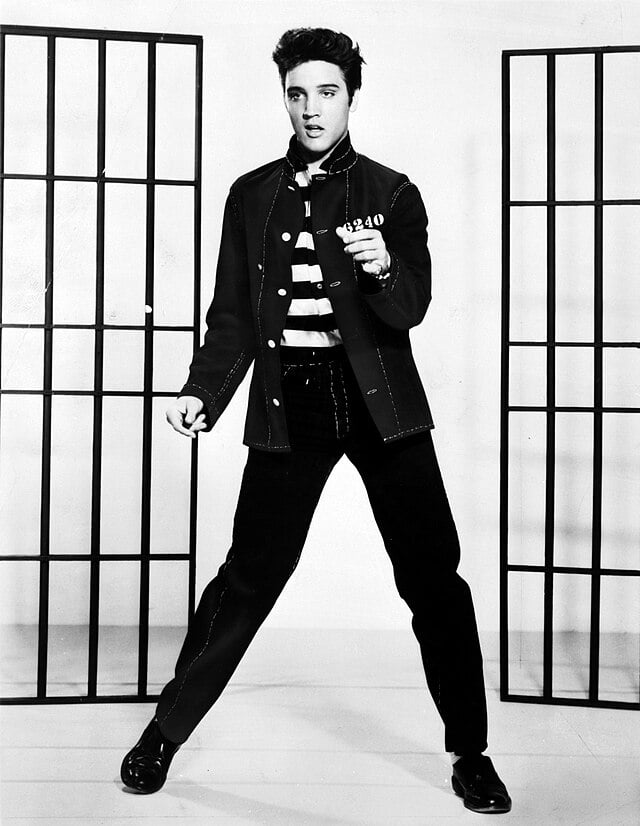
However, fame came at a cost, and Elvis faced personal struggles. Despite the challenges, his music continued to resonate. Even now, classics like “Hound Dog” and “Can’t Help Falling in Love” transcend generations.
Elvis Presley’s impact on music and culture is undeniable. He was known for his unique voice, charismatic persona, and electrifying performances. He sold over one billion records worldwide, making him one of the best-selling solo artists in history. He received numerous awards throughout his career, including three Grammy Awards and the Grammy Lifetime Achievement Award.
Elvis’s influence can still be seen in today’s music. Many contemporary artists, such as Bruno Mars, Lady Gaga, and Justin Timberlake, have cited Elvis as an inspiration. His music continues to be featured in movies, TV shows, and commercials.
Elvis left us in 1977, but his legacy lives on. I appreciate his breaking barriers and fearlessly embracing his artistic vision. Elvis Presley’s impact on music and culture is timeless, a testament to the enduring power of his artistry. His music has inspired generations and will continue to do so for many years to come.

Teaching Resources
Use our resources and tools to improve your student’s writing skills through proven teaching strategies.
BIOGRAPHY WRITING TEACHING IDEAS AND LESSONS
We have compiled a sequence of biography-related lessons or teaching ideas that you can follow as you please. They are straightforward enough for most students to follow without further instruction.
BIOGRAPHY LESSON IDEA # 1:
This session aims to give students a broader understanding of what makes a good biography.
Once your students have compiled a comprehensive checklist of the main features of a biography, allow them to use it to assess some biographies from your school library or on the internet using the feature checklist.
When students have assessed a selection of biographies, take some time as a class to discuss them. You can base the discussion around the following prompts:
- Which biographies covered all the criteria from their checklist?
- Which biographies didn’t?
- Which biography was the most readable in terms of structure?
- Which biography do you think was the least well-structured? How would you improve this?
Looking at how other writers have interpreted the form will help students internalize the necessary criteria before attempting to produce a biography. Once students have a clear understanding of the main features of the biography, they’re ready to begin work on writing a biography.
When the time does come to put pen to paper, be sure they’re armed with the following top tips to help ensure they’re as well prepared as possible.
BIOGRAPHY LESSON IDEA # 2:
This session aims to guide students through the process of selecting the perfect biography subject.
Instruct students to draw up a shortlist of three potential subjects for the biography they’ll write.
Using the three criteria mentioned in the writing guide (Interest, Merit, and Information), students award each potential subject a mark out of 5 for each of the criteria. In this manner, students can select the most suitable subject for their biography.
BIOGRAPHY LESSON IDEA # 3:
This session aims to get students into the researching phase and then prioritise events and organise them chronologically.
Students begin by making a timeline of their subject’s life, starting with their birth and ending with their death or the present day. If the student has yet to make a final decision on the subject of their biography, a family member will often serve well for this exercise as a practice exercise.
Students should research and gather the key events of the person’s life, covering each period of their life from when they were a baby, through childhood and adolescence, right up to adulthood and old age. They should then organize these onto a timeline. Students can include photographs with captions if they have them.
They can present these to the class when they have finished their timelines.
BIOGRAPHY LESSON IDEA # 4:
Instruct students to look over their timeline, notes, and other research. Challenge them to identify three patterns that repeat throughout the subject’s life and sort all the related events and incidents into specific categories.
Students should then label each category with a single word. This is the thematic concept or the broad general underlying idea. After that, students should write a sentence or two expressing what the subject’s life ‘says’ about that concept.
This is known as the thematic statement . With the thematic concepts and thematic statements identified, the student now has some substantial ideas to explore that will help bring more profound meaning and wider resonance to their biography.
BIOGRAPHY LESSON IDEA # 5:
Instruct students to write a short objective account of an event in their own life. They can write about anyone from their past. It needn’t be more than a couple of paragraphs, but the writing should be strictly factual, focusing only on the objective details of what happened.
Once they have completed this, it’s time to rewrite the paragraph, but they should include some opinion and personal commentary this time.
The student here aims to inject some color and personality into their writing, to transform a detached, factual account into a warm, engaging story.

Get our FREE Biography Writing Graphic Organizer
Use this valuable tool in the research and writing phases to keep your students on track and engaged.
WRITING CHECKLIST & RUBRIC BUNDLE

To Conclude
By this stage, your students should have an excellent technical overview of a biography’s essential elements.
They should be able to choose their subject in light of how interesting and worthy they are, as well as give consideration to the availability of information out there. They should be able to research effectively and identify emerging themes in their research notes. And finally, they should be able to bring some of their personality and uniqueness into their retelling of the life of another.
Remember that writing a biography is not only a great way to develop a student’s writing skills; it can be used in almost all curriculum areas. For example, to find out more about a historical figure in History, to investigate scientific contributions to Science, or to celebrate a hero from everyday life.
Biography is an excellent genre for students to develop their writing skills and to find inspiration in the lives of others in the world around them.
HOW TO WRITE A BIOGRAPHY TUTORIAL VIDEO

OTHER GREAT ARTICLES RELATED TO BIOGRAPHY WRITING
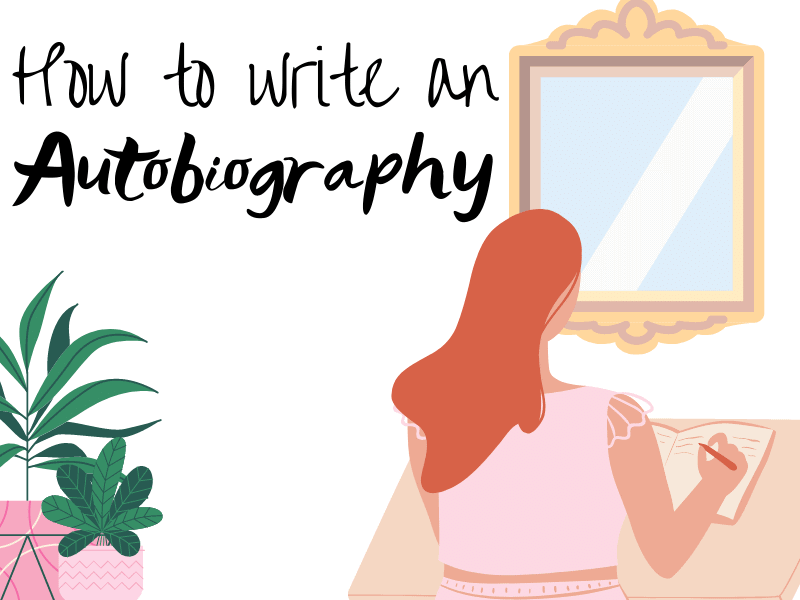
How to write an Autobiography

How to Write a Historical Recount Text

15 Awesome Recount & Personal Narrative Topics

Personal Narrative Writing Guide
- PRO Courses Guides New Tech Help Pro Expert Videos About wikiHow Pro Upgrade Sign In
- EDIT Edit this Article
- EXPLORE Tech Help Pro About Us Random Article Quizzes Request a New Article Community Dashboard This Or That Game Popular Categories Arts and Entertainment Artwork Books Movies Computers and Electronics Computers Phone Skills Technology Hacks Health Men's Health Mental Health Women's Health Relationships Dating Love Relationship Issues Hobbies and Crafts Crafts Drawing Games Education & Communication Communication Skills Personal Development Studying Personal Care and Style Fashion Hair Care Personal Hygiene Youth Personal Care School Stuff Dating All Categories Arts and Entertainment Finance and Business Home and Garden Relationship Quizzes Cars & Other Vehicles Food and Entertaining Personal Care and Style Sports and Fitness Computers and Electronics Health Pets and Animals Travel Education & Communication Hobbies and Crafts Philosophy and Religion Work World Family Life Holidays and Traditions Relationships Youth
- Browse Articles
- Learn Something New
- Quizzes Hot
- This Or That Game New
- Train Your Brain
- Explore More
- Support wikiHow
- About wikiHow
- Log in / Sign up
- Education and Communications
How to Write a Biography
Last Updated: April 1, 2024 Fact Checked
This article was co-authored by Stephanie Wong Ken, MFA . Stephanie Wong Ken is a writer based in Canada. Stephanie's writing has appeared in Joyland, Catapult, Pithead Chapel, Cosmonaut's Avenue, and other publications. She holds an MFA in Fiction and Creative Writing from Portland State University. There are 7 references cited in this article, which can be found at the bottom of the page. This article has been fact-checked, ensuring the accuracy of any cited facts and confirming the authority of its sources. This article has been viewed 1,850,570 times.
Writing a biography can be a fun challenge, where you are sharing the story of someone’s life with readers. You may need to write a biography for a class or decide to write one as a personal project. Once you have identified the subject of the biography, do your research so you know as much about them as possible. Then, dive into the writing of the biography and revising it until it is at its finest.
Researching Your Subject

- If the subject does not give you permission to write the biography, you may want to choose a different subject. If you decide to publish the biography without the subject’s permission, you may be susceptible to legal action by the subject.
- If the subject is no longer alive, you obviously do not need to ask permission to write about them.

- You may create research questions to help focus your research of the subject, such as, What do I find interesting about the subject? Why is this subject important to readers? What can I say that is new about the subject? What would I like to learn more about?

- For in person interviews, record them with a tape recorder or a voice recorder on your computer or phone.
- You may need to interview the subject and others several times to get the material you need.

- You may also want to visit areas where the subject made a major decision or breakthrough in their life. Being physically in the area can give you a sense of how the subject might have felt and help you write their experiences more effectively.

- When researching the time period ask yourself: What were the social norms of that time? What was going on economically and politically? How did the social and political climate affect the subject?

- You may also include historical events or moments that affected the subject on the timeline. For example, maybe there was a conflict or civil war that happened during the person’s life that affected their life.
Writing the Biography

- You may end up focusing on particular areas of the person’s life. If you do this, work through a particular period in the person’s life chronologically.

- For example, you may have a thesis statement about focusing on how the person impacted the civil rights movement in America in the 1970s. You can then make sure all your content relates back to this thesis.

- Flashbacks should feel as detailed and real as present day scenes. Use your research notes and interviews with the subject to get a good sense of their past for the flashbacks.
- For example, you may jump from the person’s death in the present to a flashback to their favorite childhood memory.

- For example, you may focus on the person’s accomplishments in the civil rights movement. You may write a whole section about their contributions and participation in major civil rights marches in their hometown.

- For example, you may notice that the person’s life is patterned with moments of adversity, where the person worked hard and fought against larger forces. You can then use the theme of overcoming adversity in the biography.

- For example, you may note how you see parallels in the person’s life during the civil rights movement with your own interests in social justice. You may also commend the person for their hard work and positive impact on society.
Polishing the Biography

- Revise the biography based on feedback from others. Do not be afraid to cut or edit down the biography to suit the needs of your readers.

- Having a biography riddled with spelling, grammar, and punctuation errors can turn off your readers and result in a poor grade if you are handing in the text for a class.

- If the biography is for a class, use MLA , APA , or Chicago Style citations based on the preferences of your instructor.
Biography Help

Community Q&A
- Be careful when publishing private or embarrassing information, especially if the person is not a celebrity. You may violate their "Right of Privacy" or equivalent. Thanks Helpful 31 Not Helpful 5
- Have the sources to back up your statements about the subject's life. Untruthful written statements can lead to litigation. If it is your opinion, be clear that it is such and not fact (although you can support your opinion with facts). Thanks Helpful 16 Not Helpful 15

You Might Also Like

- ↑ http://grammar.yourdictionary.com/writing/how-to-write-a-biography.html
- ↑ https://au.indeed.com/career-advice/career-development/how-to-write-a-bio
- ↑ https://grammar.yourdictionary.com/writing/how-to-write-a-biography.html
- ↑ https://www.writersdigest.com/writing-articles/3-tips-for-writing-successful-flashbacks
- ↑ https://www.grammarly.com/blog/how-to-write-bio/
- ↑ https://writingcenter.unc.edu/tips-and-tools/editing-and-proofreading/
- ↑ https://www.plagiarism.org/article/how-do-i-cite-sources
About This Article

Before you write a biography, gather as much information about the subject that you can from sources like newspaper articles, interviews, photos, existing biographies, and anything else you can find. Write the story of that person’s life, including as much supporting detail as you can, including information about the place and time where the person lived. Focus on major events and milestones in their life, including historical events, marriage, children, and events which would shape their path later in life. For tips from our reviewer on proofreading the biography and citing your sources, keep reading! Did this summary help you? Yes No
- Send fan mail to authors
Reader Success Stories
Nov 7, 2023
Did this article help you?
Jan 24, 2021
Janis Hendrick
Oct 10, 2018
Teresa Bradley
Sep 15, 2020
Apr 18, 2016

Featured Articles

Trending Articles

Watch Articles

- Terms of Use
- Privacy Policy
- Do Not Sell or Share My Info
- Not Selling Info
wikiHow Tech Help Pro:
Level up your tech skills and stay ahead of the curve

Biography Outline Template – 15+ Formats, Samples and Examples
A Biography is a written account of one person’s life written by someone else. Most biographies are written about people of notable interest, and people who have made an impression on society that has lasted, or will last, long after the end of that person’s life. Depending on the individual, their achievements, and span of life, a writer can easily find him/herself writing a long piece. As with writing anything, Biographies are no different in that the process and the author are both greatly helped by the Biography Outline, and Biography Outline Template. Because of the length any biography is bound to have the Biography Outline organizes the relevant information in the correct sequence for the writing process. The blank outline template gives the writer a general idea of where to start, what to include, and how best to complete the Biography Outline.
Every Biography, despite the type, is going to have some basic information such as; the name of the Biography’s subject; their date and place of birth; who their parents are and what they did; childhood facts or stories; relevant information about the person’s adulthood- assuming the subject lived into adulthood; the reason for this person’s fame; facts about their current life or late life; and date and place of death, when applicable. The general outline for a biography can change depending on the needs of the writer, and the order can change as well if the central idea or theme requires this. Organizing the relevant information into a Biography Outline Template can guide the writer, and organize the writing process.
Here are some biography outline formats, samples and examples to help you with your outline.
Table of Contents
Biography Outline Template for Word
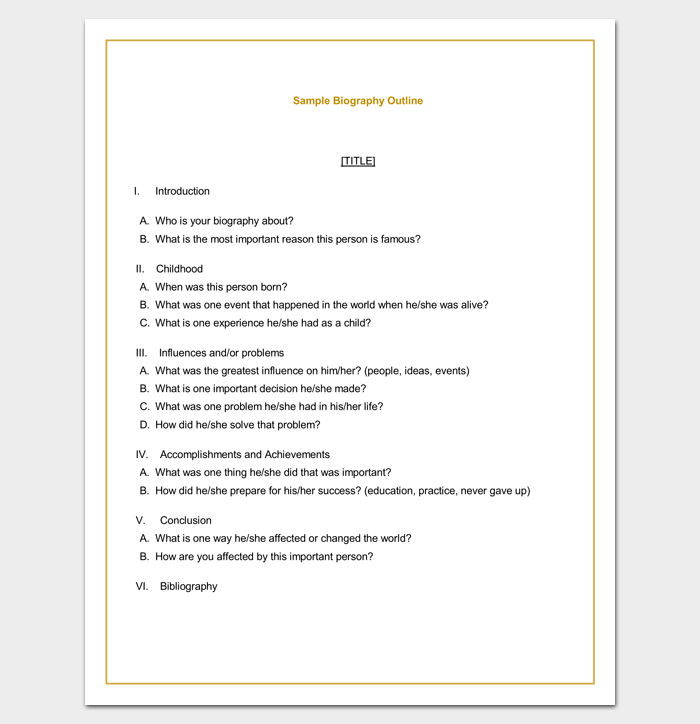
Free Download
Biography Report Outline Template for Word Doc

Biography Outline Format
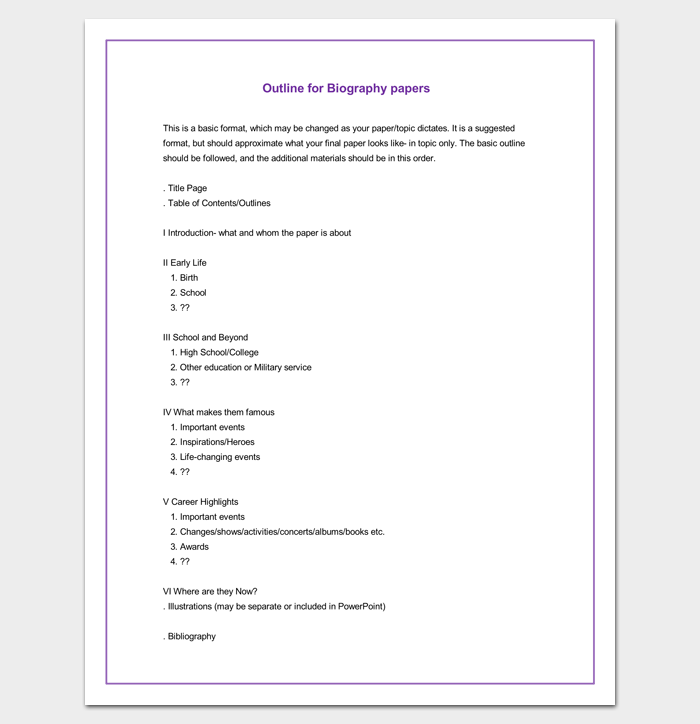
Biography Outline Template for PDF
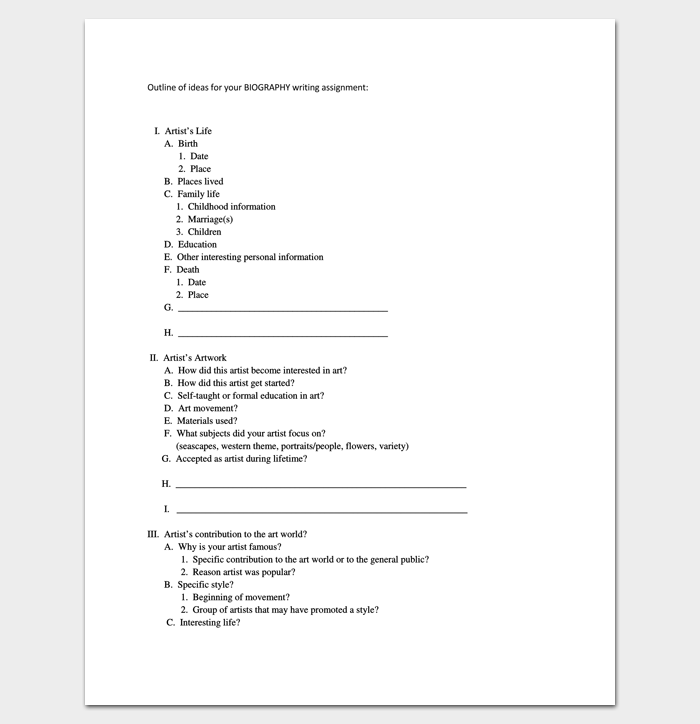
5 Paragraph Biography Essay Outline Format
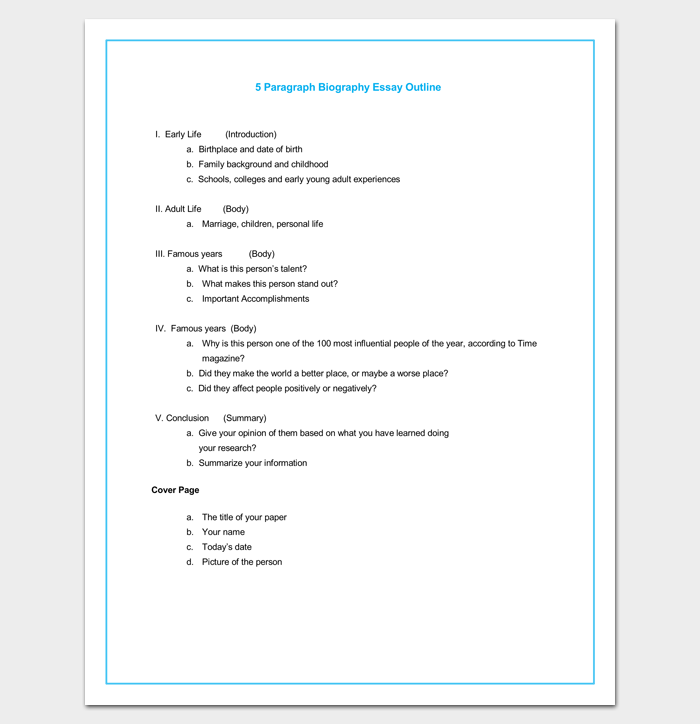
Biography Outline 4th Grade

Biography Outline for 5th Grade
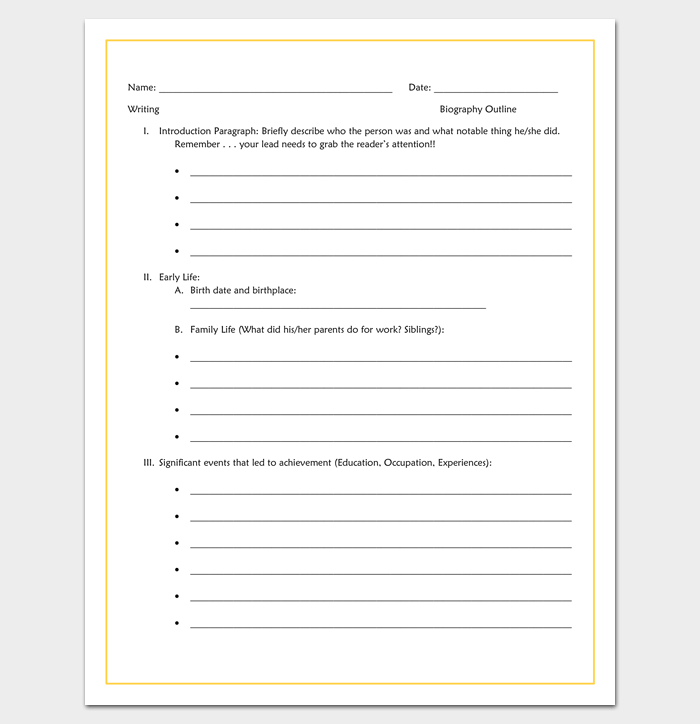
Biography Report Outline Template for PDF

Biography Book Report Outline Template
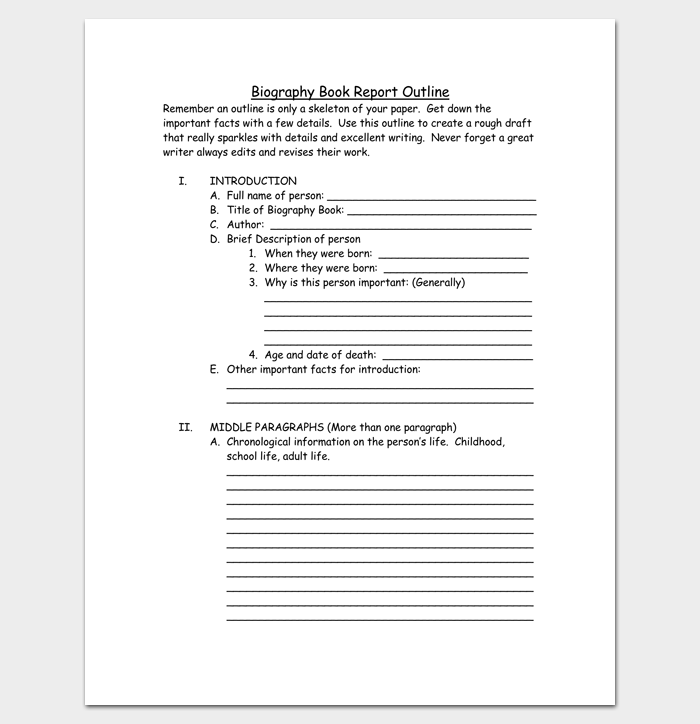
Biography Outline Worksheet
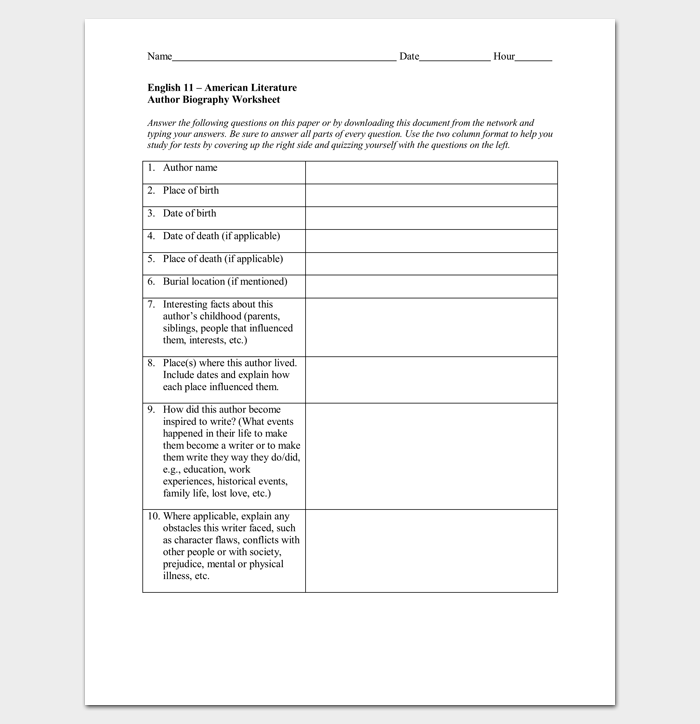
Biography Outline Sample (Albert Schweitzer)
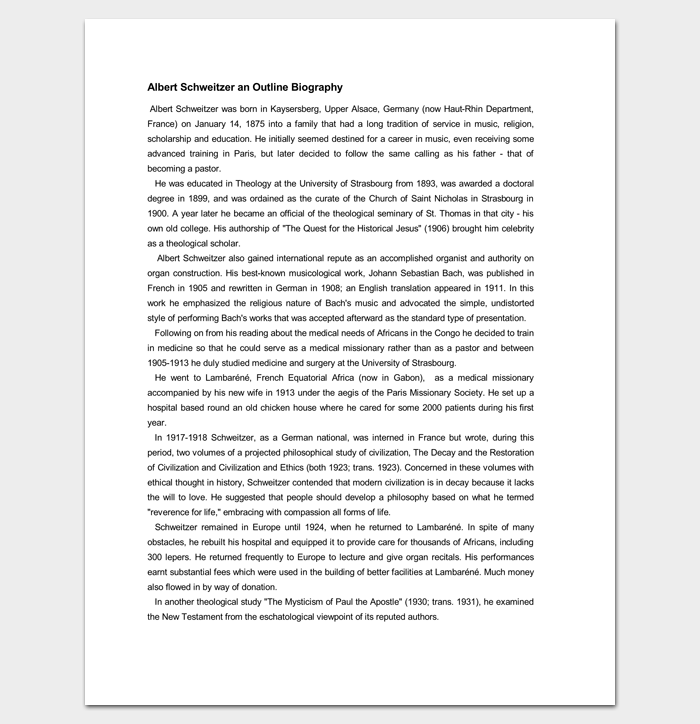
Shakespeare Biography Outline in PDF Format
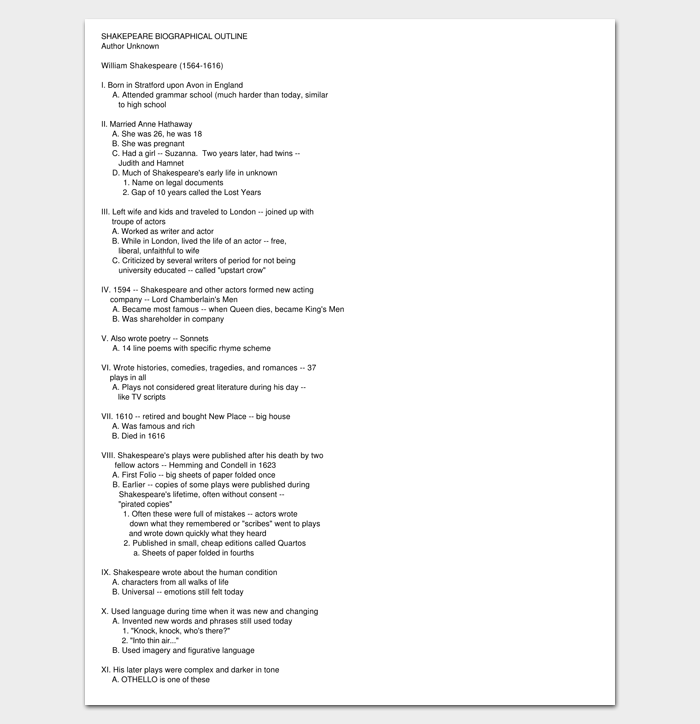
Personal Biography Outline (+ How to Write Guide)

How to Write a Biography Outline in Microsoft® Word
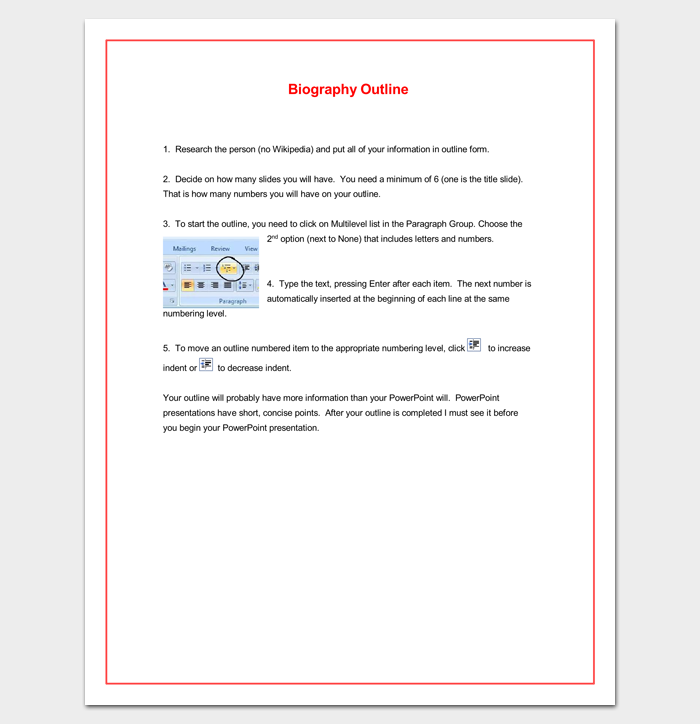
How to Write an Outline

Tips for Writing a Biography Outline
- Organization is key- Because of the sheer volume of information an individual can accumulate within the span of a life, organization is key. Organizing facts, figures, demographics, and geographic information relevant to an individual’s life makes notation during the writing process simple. This material should be compiled and organized before completing the Biography Outline for ease of use and access.
- Chronological may or may not be logical- In most cases a biography will start at the beginning. However, if you find that the main idea or theme of the biography is better served by starting at another point, and working backwards, or across, then the outlining process will highlight this necessity for you.
- Rigidity is not a virtue- Remember that the Biography Outline Template and the completed Biography Outline is malleable. Inflexibility breaks, whereas malleability bends. If a particular bullet point within the template isn’t relevant, then don’t use it. If, once your outline is complete, you find that changes need to be made then make them. The purpose of these tools is to provide a guided path for organization of thought, ease of writing, and time efficiency. They’re not meant to be a train ride with no stops, or junctions. That would just be a wreck. you may also like literature review outline template .
Share this:
- Click to share on Twitter (Opens in new window)
- Click to share on Facebook (Opens in new window)
Add comment
- Agenda Templates
- Agreement Templates
- Certificates Templates
- Envelopes Templates
- Invoices Templates
- Lists Templates
- Letterhead Templates
- Memos Templates
- MOU Templates
- Minutes Templates
- Resumes Templates
- Receipts Templates
- Budgets Templates
Advertisements
- Certificates
- Marriage Certificates

A biography is a detailed account of a person’s life, documenting their experiences, achievements, and impact on the world. It explores the subject’s personal and professional journeys, offering insights into their character and legacy.
What is Biography? A biography is a written account of another person’s life, detailing their experiences, accomplishments, and the impact they’ve made on the world . It provides an in-depth look at the subject’s life from birth to death, highlighting significant events, personal milestones, challenges they faced, and their contributions to society. Biographies are often based on extensive research and include interviews, historical documents, and other sources to paint a comprehensive picture of the individual’s life. They serve to inform, inspire, and sometimes educate readers about notable figures, offering insights into their personalities, motivations, and the context in which they lived and worked.
Types of Biography
Biographies come in various forms, each offering a unique perspective on an individual’s life. Understanding the types of biographies can help readers choose the one that best suits their interest or research needs. Here are the main types:
1. Autobiography
- Description: Written by the subject themselves, an autobiography is a self-narrated account of one’s life. It provides personal insights and perspectives, offering a detailed look into the author’s experiences, thoughts, and feelings.
- Focus: Personal journey, challenges, successes, and reflections.
- Description: A memoir is a subset of autobiography but focuses more on specific aspects or periods of the writer’s life rather than a comprehensive life history. It often explores themes, emotions, and personal growth.
- Focus: Emotional journey, significant events, or relationships.
3. Biography
- Description: A biography is an account of someone’s life written by someone else. It covers various aspects of the subject’s life, including their achievements, personal life, and impact on society.
- Focus: Objective analysis, historical context, and comprehensive life story.
4. Authorized Biography
- Description: Authorized biographies are written with the subject’s permission, cooperation, or endorsement. This access can lead to more detailed and personal insights but may also reflect the subject’s bias or desired legacy.
- Focus: Collaborative storytelling, often with direct input from the subject.
**5. Unauthorized Biography
- Description: Written without the subject’s permission, unauthorized biographies might offer a more critical or controversial perspective. They rely on public records and third-party interviews, which can lead to disputes about accuracy.
- Focus: Independent research, potentially revealing unknown aspects.
6. Academic Biography
- Description: These biographies are written with a focus on scholarly research, often detailing the subject’s contributions to a specific field. They are usually well-documented and cited, aiming for academic audiences.
- Focus: Scholarly analysis, contributions to the field, and historical impact.
7. Collective Biography
- Description: Also known as group biography, it explores the lives of a group of individuals who share a common theme, profession, or period. It provides a broader perspective on the impact of a collective group.
- Focus: Group dynamics, collective contributions, and shared experiences.
8. Fictional Biography
- Description: These are imaginative accounts that blend facts with fiction, often to fill in gaps in historical records or to create a more engaging narrative. While based on real people, these stories are partly or largely fictionalized.
- Focus: Entertainment, speculative history, and narrative creativity.
Format of Biography
A well-structured biography format ensures that the narrative is both engaging and informative, offering readers a comprehensive view of the subject’s life. Here is a structured format that can be adapted to suit different types of biographies:
Title: Should capture the essence of the subject’s life. Subtitle: Optional, providing additional context or focus. Author’s Name: The name of the biographer.
Table of Contents
Lists chapters or sections with page numbers for easy navigation.
Introduction
Introduces the subject of the biography, including their significance and the scope of the biography. Provides a thesis statement or the main theme of the biography.
Birth and Family Background: Details about the subject’s birth, parents, siblings, and early family life. Education: Information on the subject’s education, including significant schools attended, degrees earned, and influential teachers or mentors. Formative Experiences: Early experiences that shaped the subject’s character, interests, and future path.
Early Career: Overview of the subject’s initial jobs or roles and early career milestones. Major Contributions and Achievements: Detailed account of the subject’s key contributions, achievements, and career highlights. Challenges and Setbacks: Challenges faced in their career and how they were overcome.
Personal Life
Relationships and Family: Information on the subject’s personal relationships, marriage(s), children, and close friendships. Interests and Hobbies: The subject’s personal interests, hobbies, and extracurricular activities.
Philanthropy and Activism
If applicable, details on the subject’s involvement in philanthropy, social causes, activism, or community service.
Legacy and Impact
Analysis of the subject’s legacy and impact on their field, community, or the world. Includes public and professional recognition, awards, and honors.
Later Life and Death
Details about the subject’s later years, retirement, and circumstances of their death (if applicable). Reflections on their life and contributions.
Summarizes the key points of the biography, reinforcing the subject’s impact and legacy. Reflects on the broader implications of the subject’s life and work.
Appendices (If Applicable)
Includes additional information, such as letters, documents, or photographs.
Bibliography/References
Lists sources, interviews, and materials used in researching the biography.
An alphabetical listing of names, places, and subjects mentioned in the biography, with page numbers.
1. Biography Sample
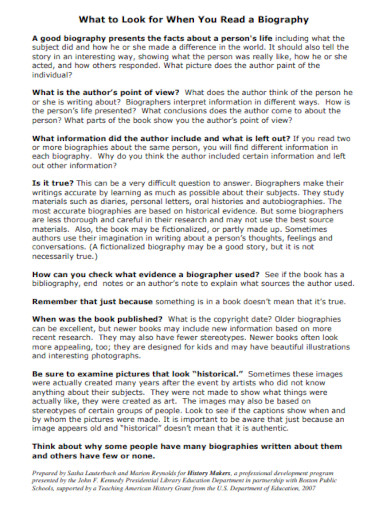
3. Biography of Heroes and Heroines
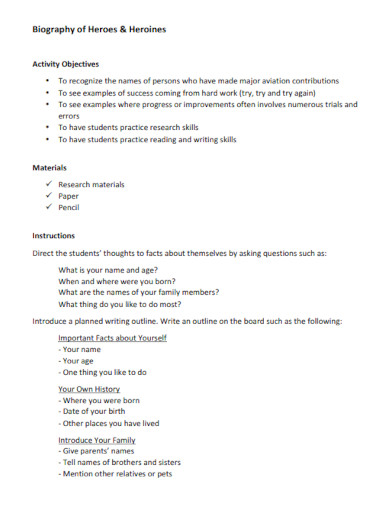
4. Biography Websites
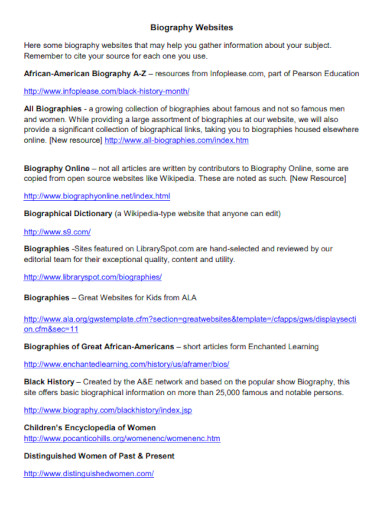
5. Social Biography
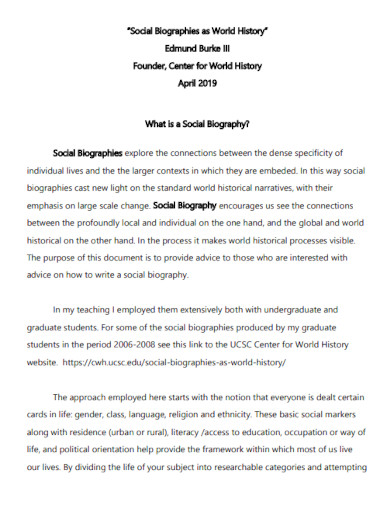
6. Professional Biography
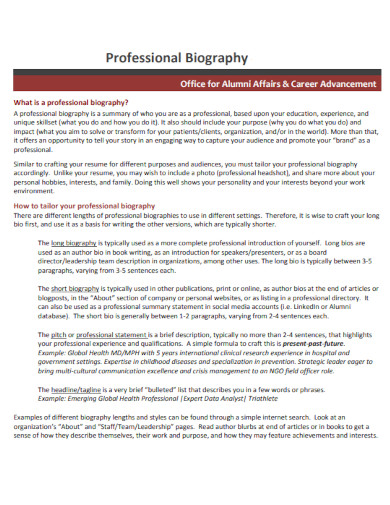
7. Biography Compare and Contrast
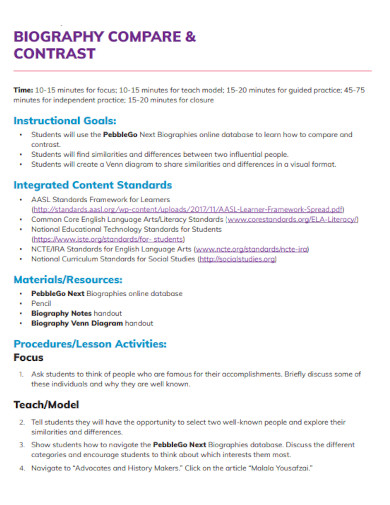
8. Author Biography
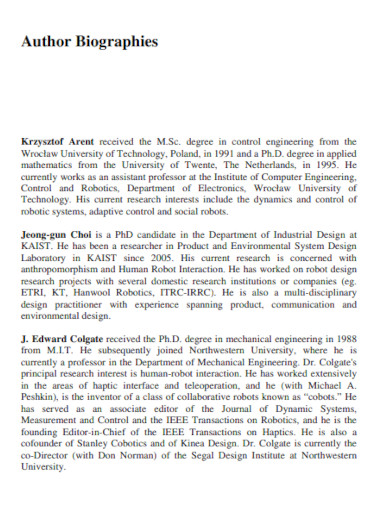
9. Gandhi a Pictorial Biography
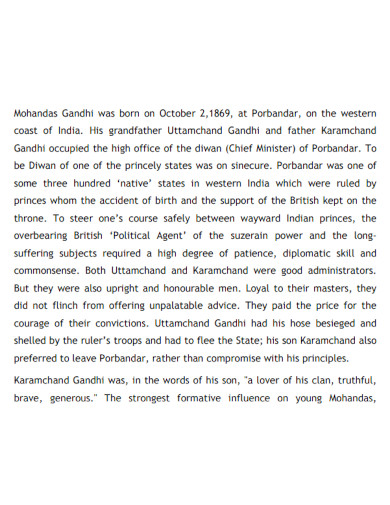
10. Plant Biography
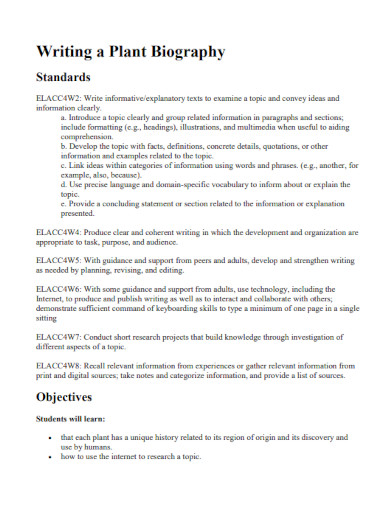
11. Short Biography
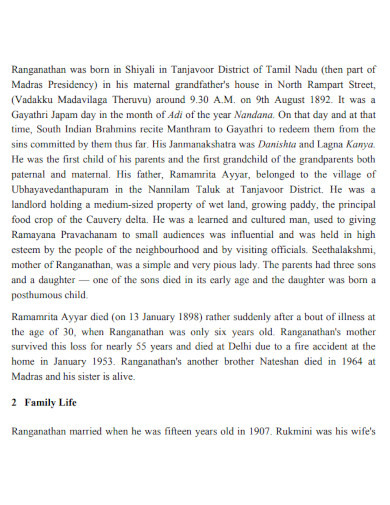

12. A Short Biography about Yourself

13. Elements of an Author Biography
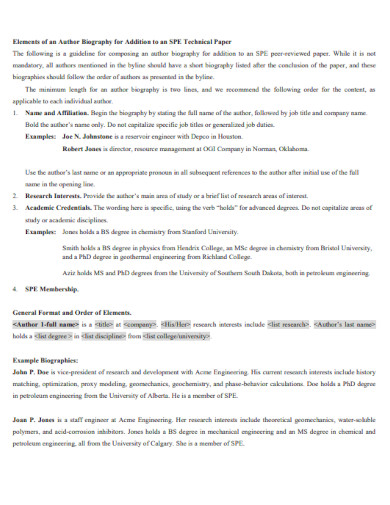
14. Biography of William Shakespeare
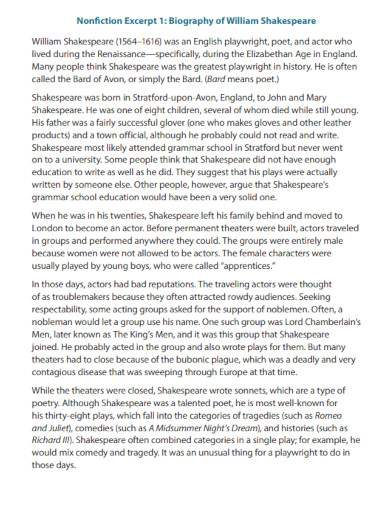
15. Biography Research Report
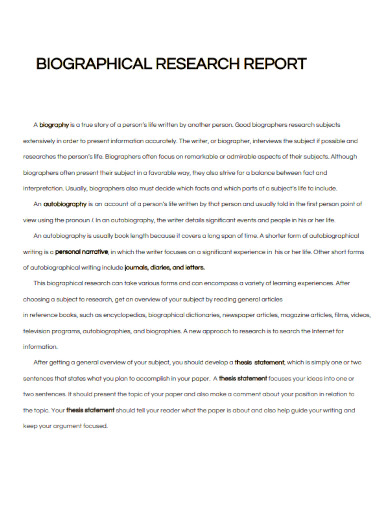
16. Biography of Bayes
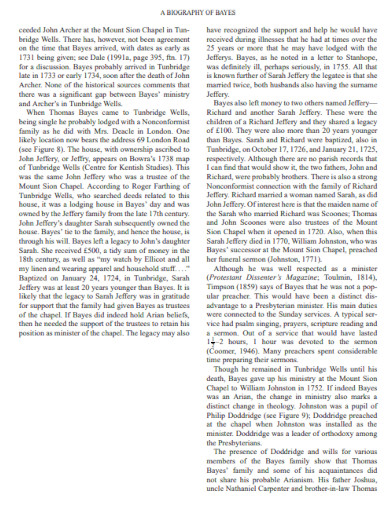
17. Modern Biography

18. Cultural Biography
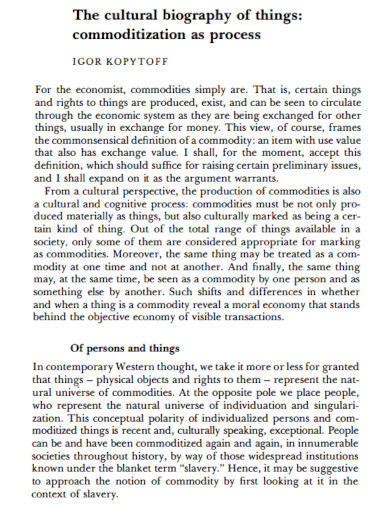
19. Biography of the Great King
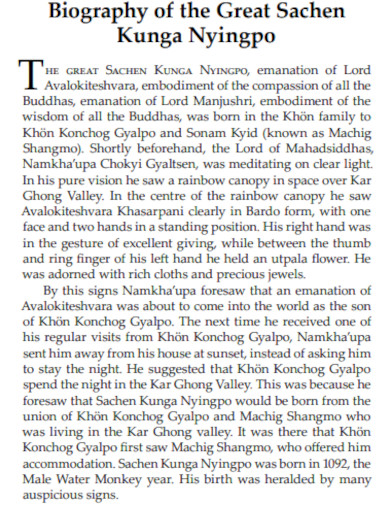
20. A biography of Dennis P Sullivan
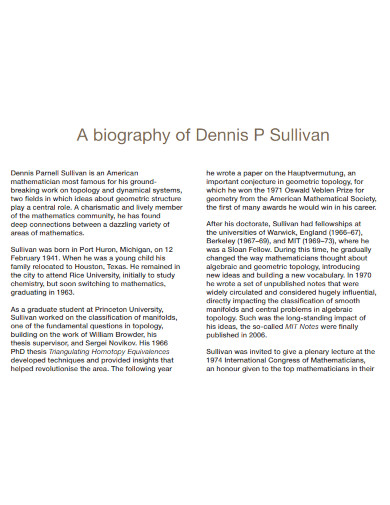
21. The Founder Biography
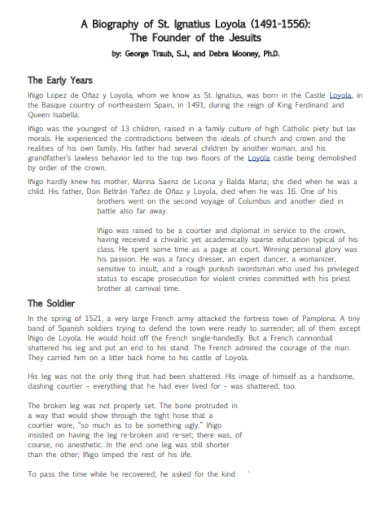
22. New Directions of Biography
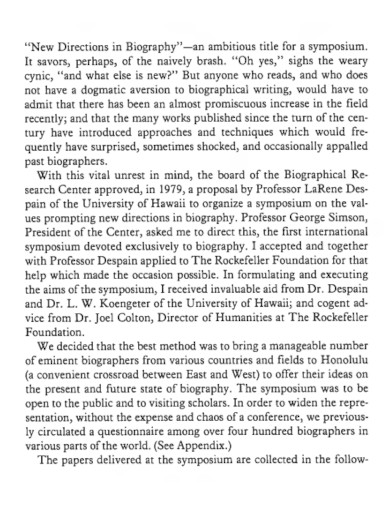
23. Student Biography
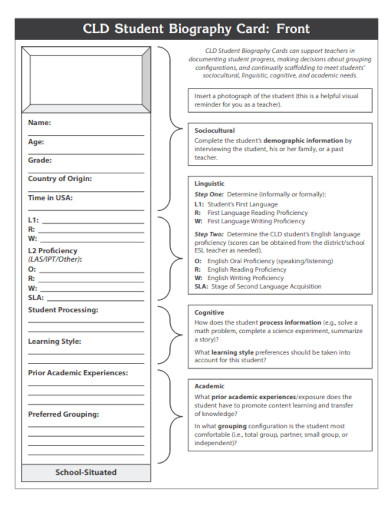
24. Historical Biography Example
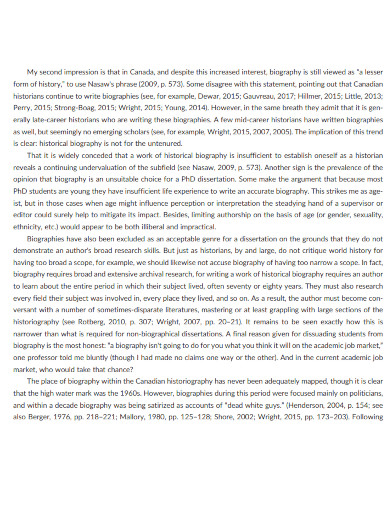
25. Generating Biography Summary

26. Judicial Biography

27. Thomas Hardy Biography
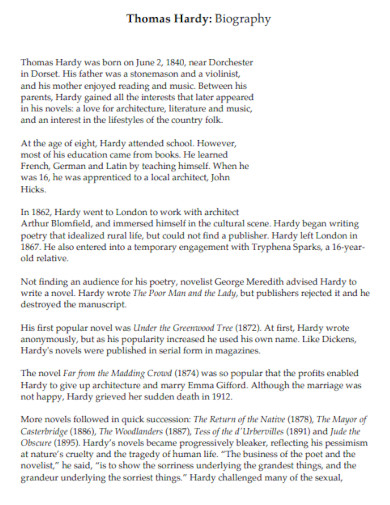
28. A Biography of Kilian Jornet
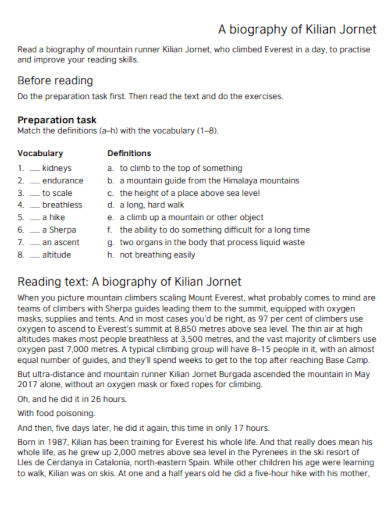
29. Rachel Carson Biography
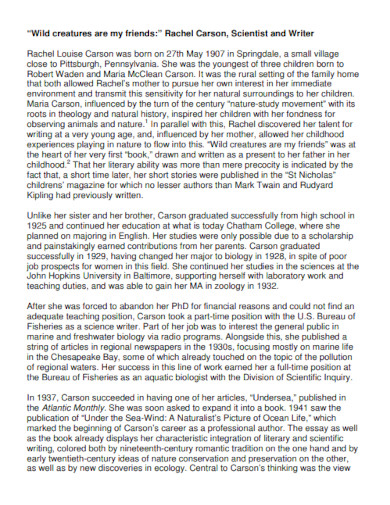
30. Sample Lecturer’s Biography
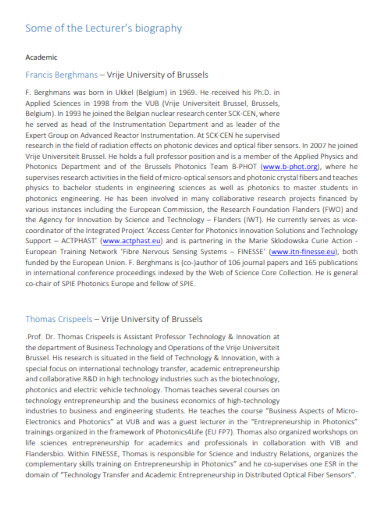
31. Object Biography

32. Literary Biography and its Critics
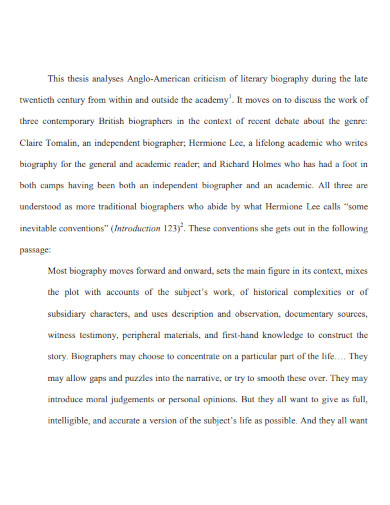
33. Biography of Helen Keller

34. Biography Cause and Effect
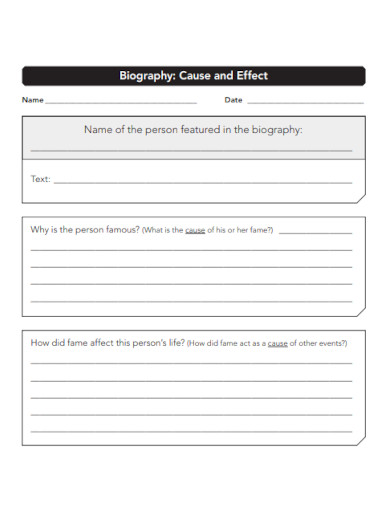
35. The Biography of the Object
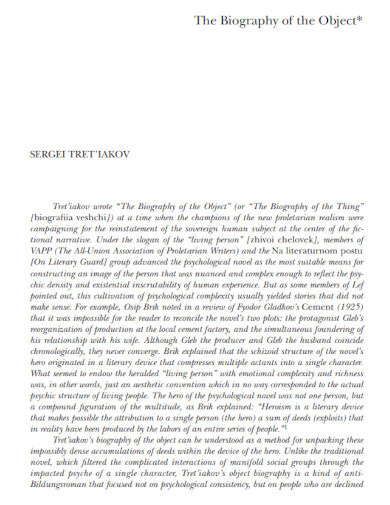
36. Bill Gates Biography
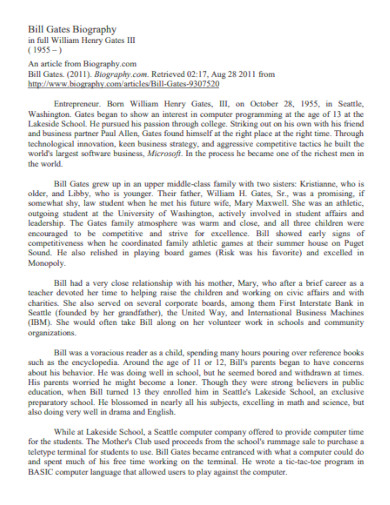
37. Features of Biography
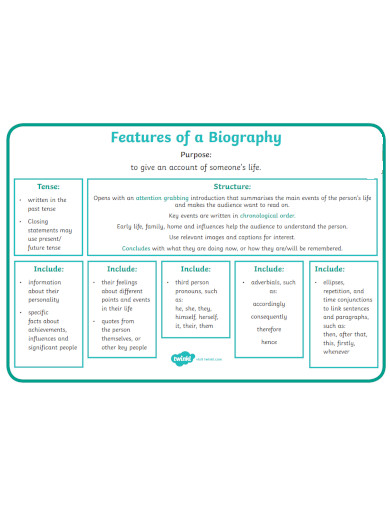
38. Semantic National Biography of Finland

39. Biography Example

40. Short Biography’s Example
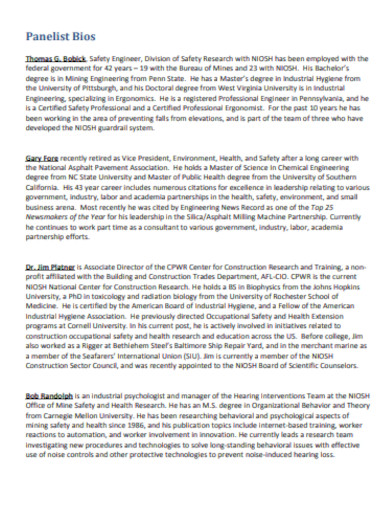
41. Sylvia Plath Biography
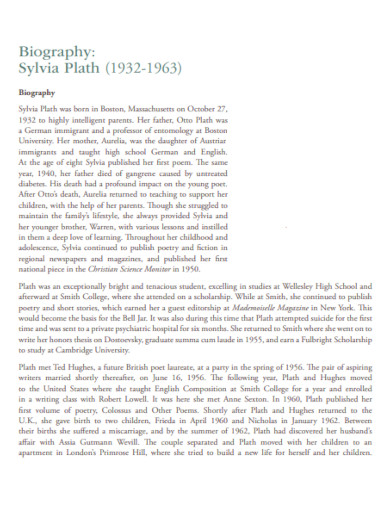
42. Biography Form
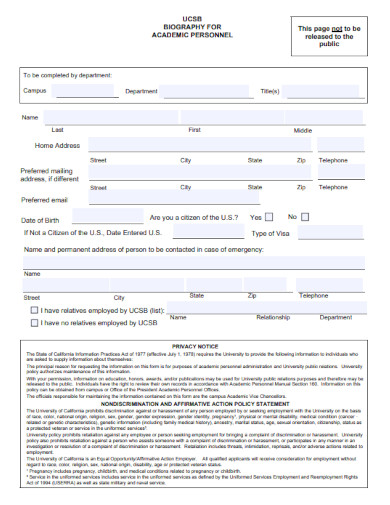
43. Former Secretary Biography
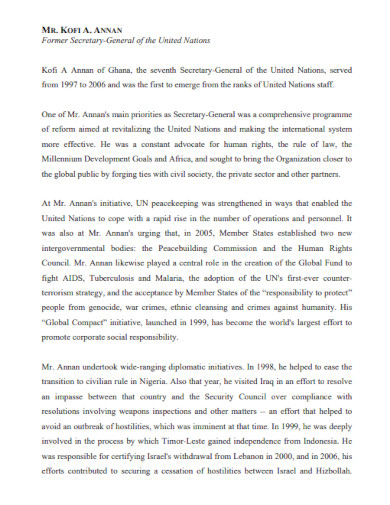
44. One Page Biography
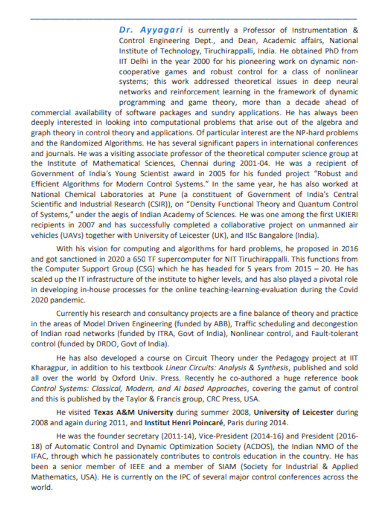
45. Cereal Box Biography Research Reports
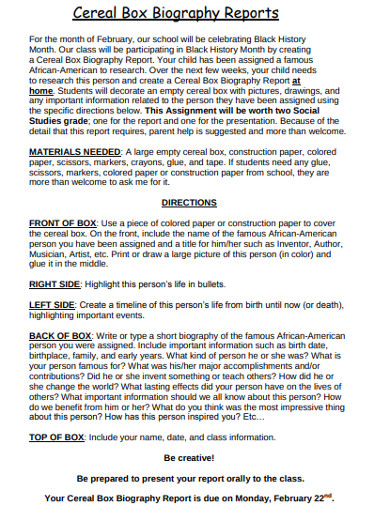
46. Author Biography Research
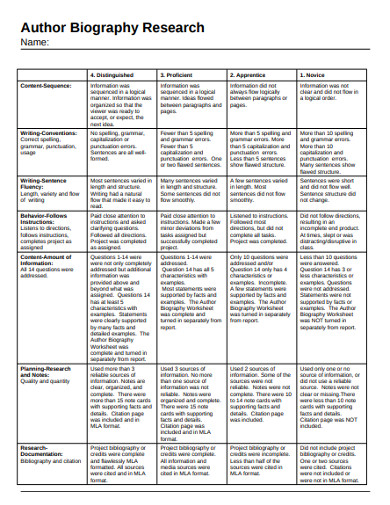
47. Biography Research Project
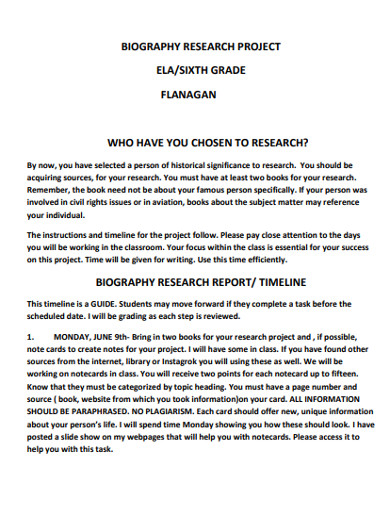
48. Biography Book Research Report
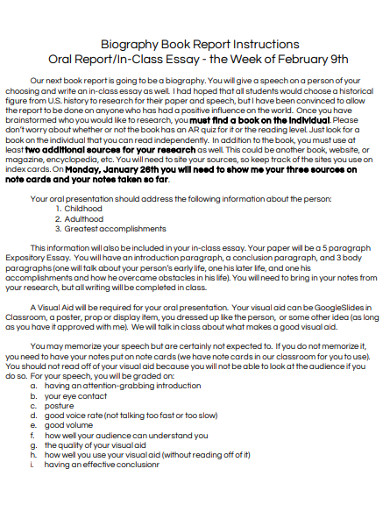
49. Budding Renaissance of Biography
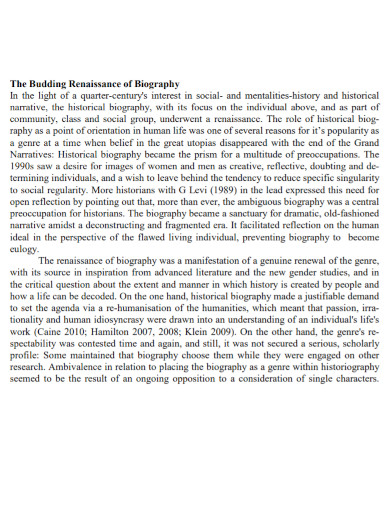
50. Biography Narrative Essay
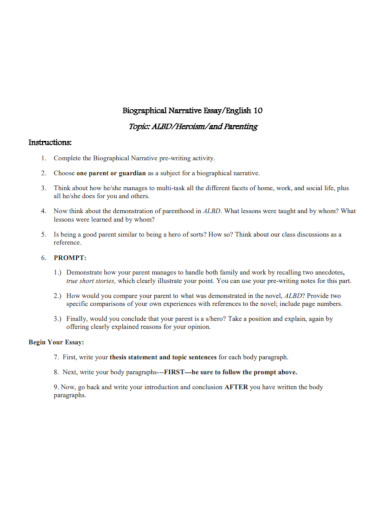
51. Abraham Lincoln Biography
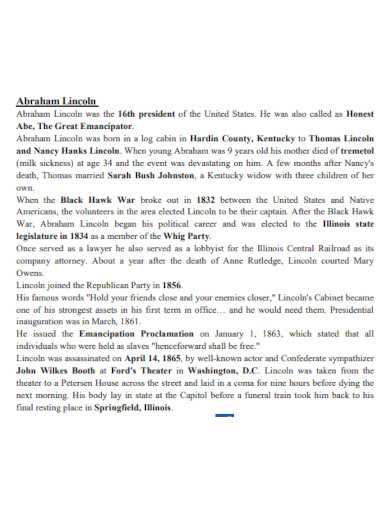
52. Albert Einstein Biography
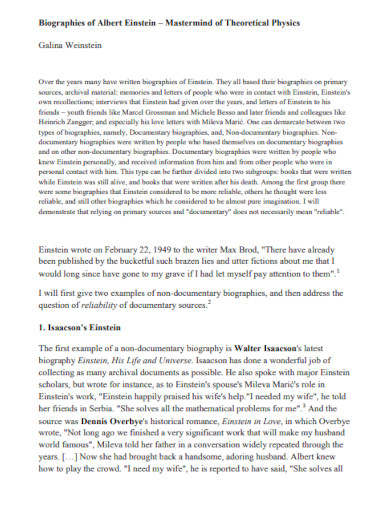
53. Michael Jackson Biography
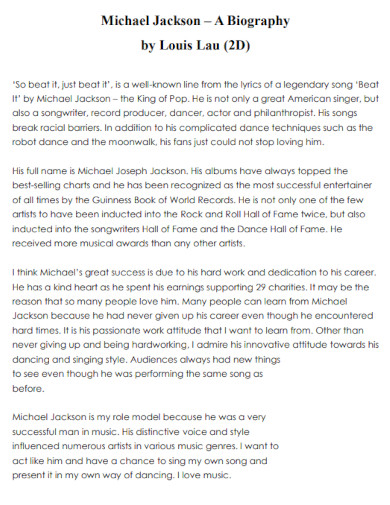
54. Albert Einstein Biography in Nutshell
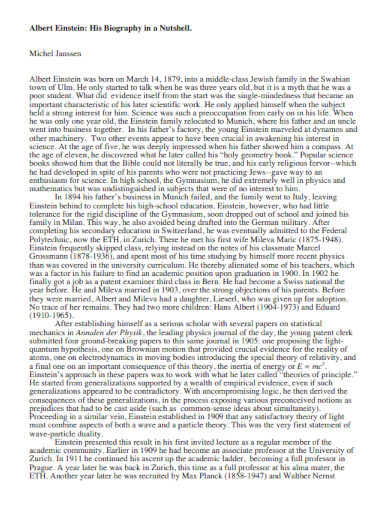
55. David Hockney Biography
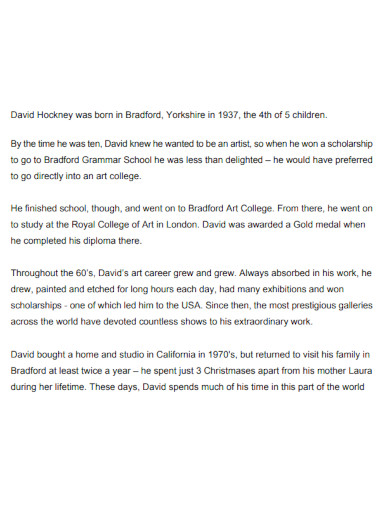
56. Women’s Biography

57. Robert Burns Biography
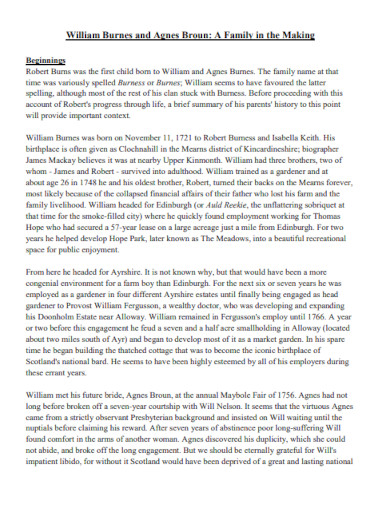
58. A Relative Biography

59. Grant Program Biographical Sketch
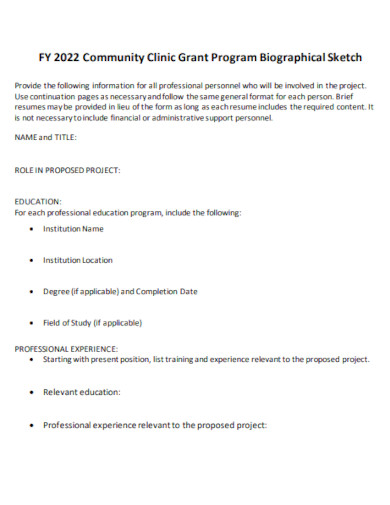
60. Grant Biography
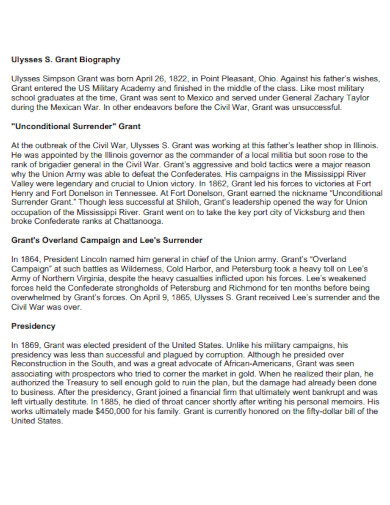
61. Feminist Biography
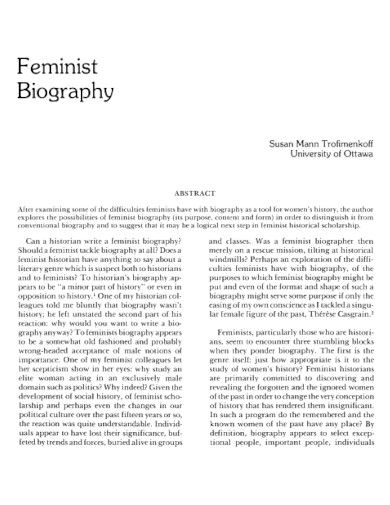
62. Biography in Pedagogical Activity
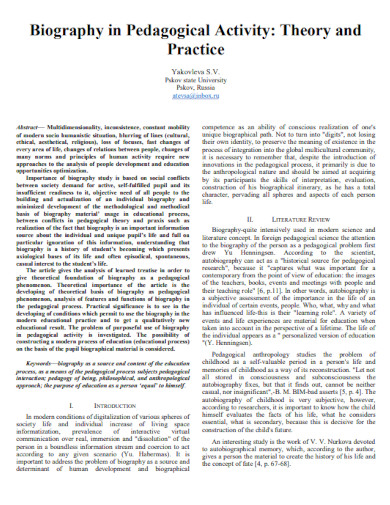
63. Biographical Notes
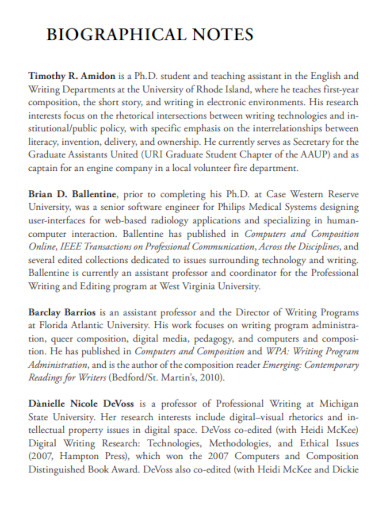
64. Biography Extraction System
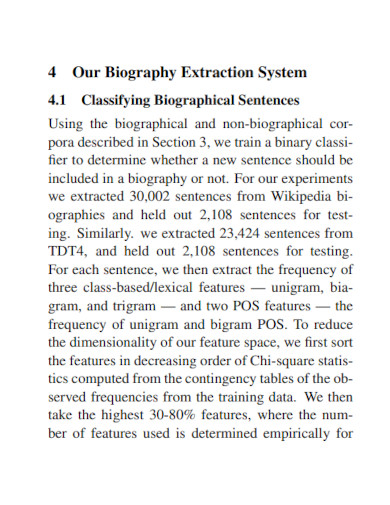
65. Short Professional Biography

66. Biography of River
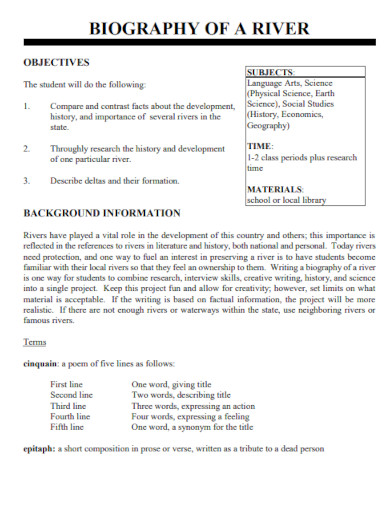
67. Biography of Panel Speaker

68. Executive Biography Template

69. Academic Biography

70. Biography Summarization
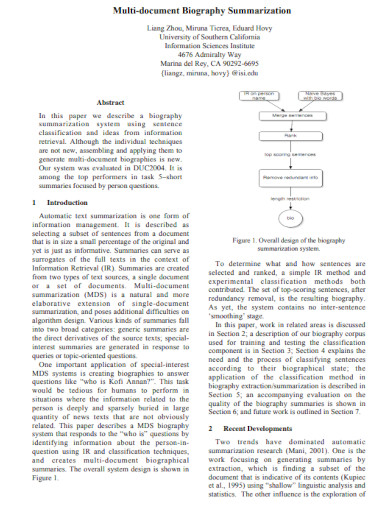
71. Biography PowerPoint Presentation

72. Biography of Alice Walker

73. Biography of Adolf Hitler
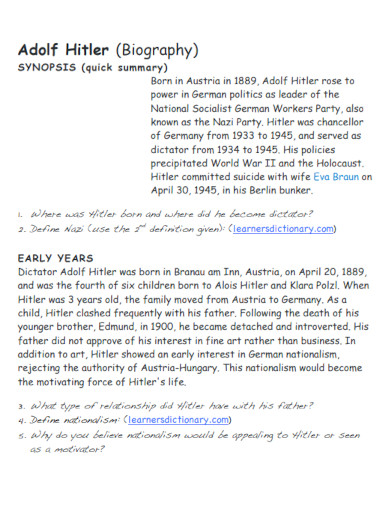
74. Osho’s Biography
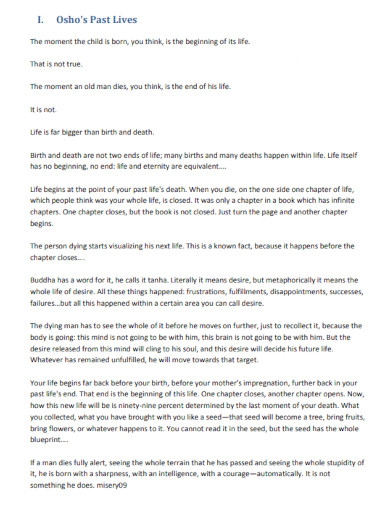
75. Interview Questions for Biography

76. Biography of Swami Vivekananda

77. Internationalization of Brand Biography
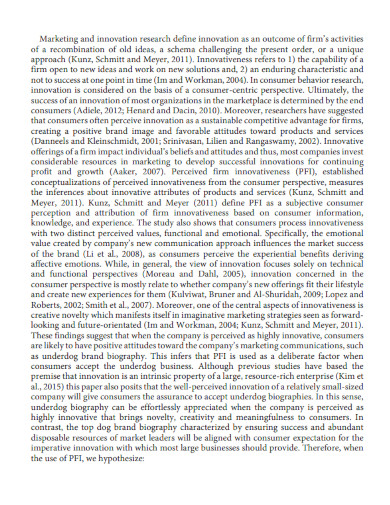
78. Biography and Geography

79. Biography Example PDF
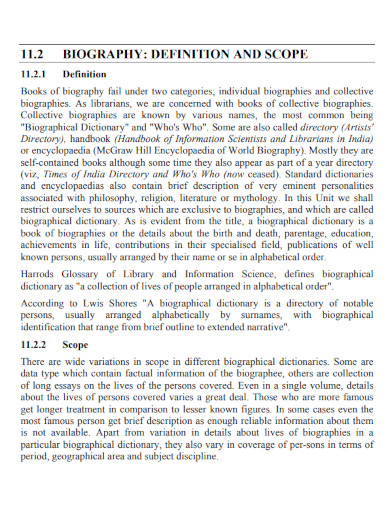
80. Draft Biography
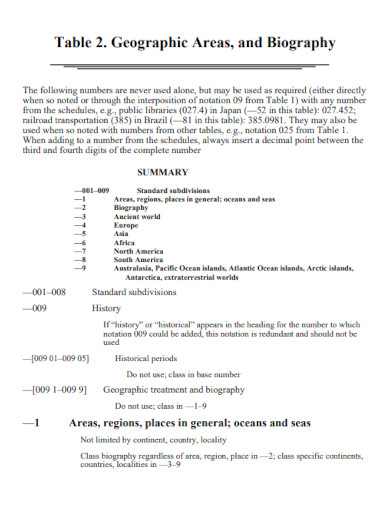
81. Object Biography Assignment
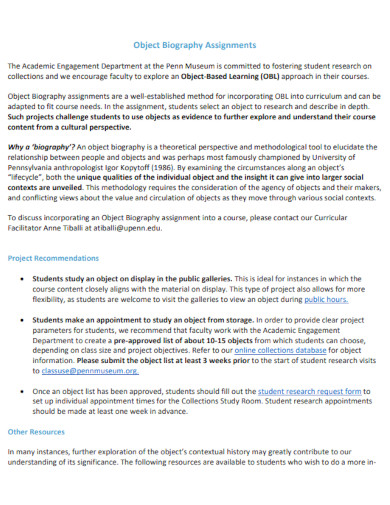
82. Short Biography in PDF

83. Biography Cards
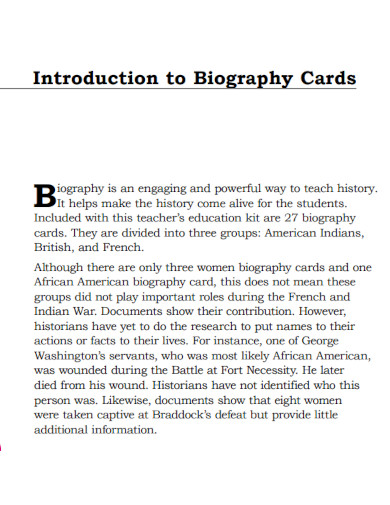
84. Activity Biography

85. Biography Activity Sheet
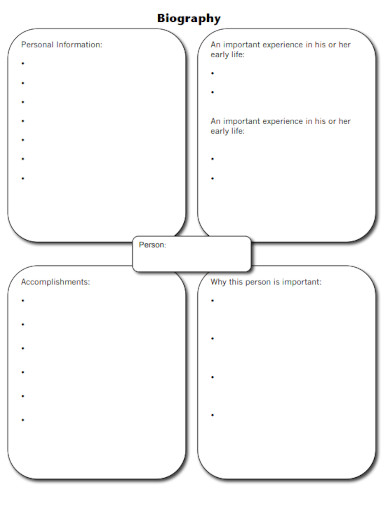
86. Biography The History of One
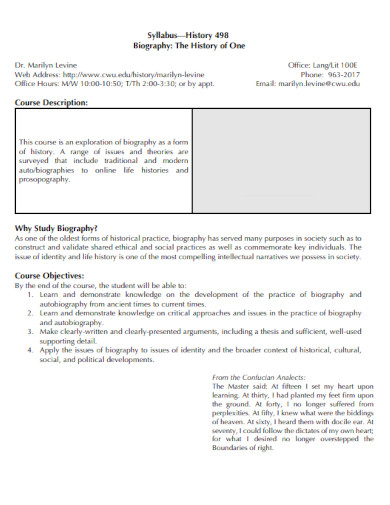
87. The Burdens of Biography
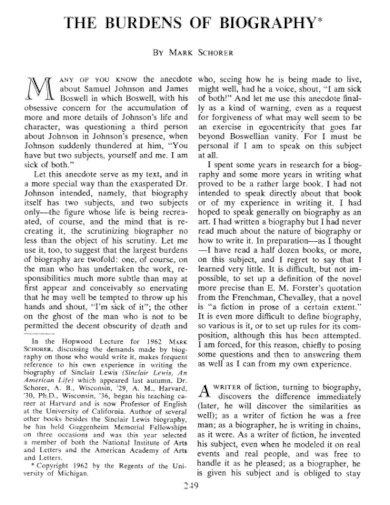
88. Features of a Biography
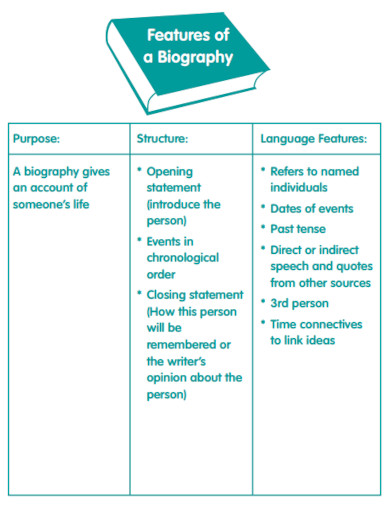
89. Biography Instruction Sheet
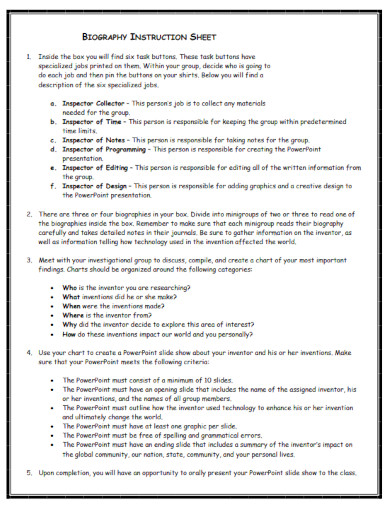
90. Biographies
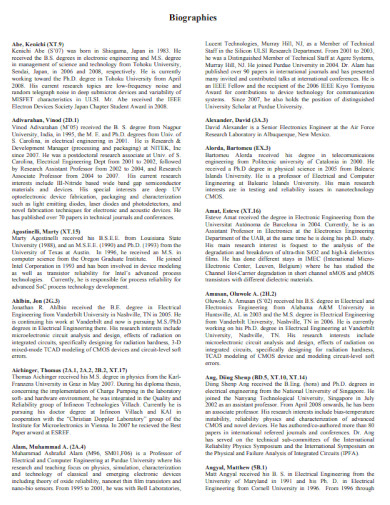
91. Biographical Research
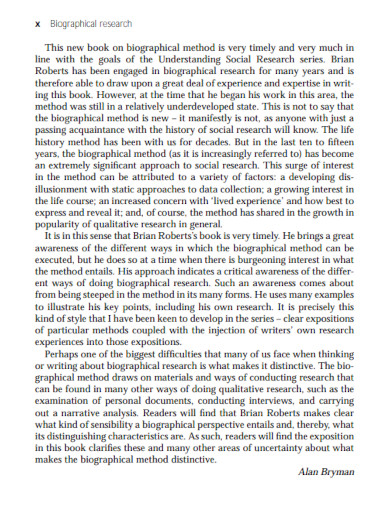
92. Biography of a Story

93. Brief Biography
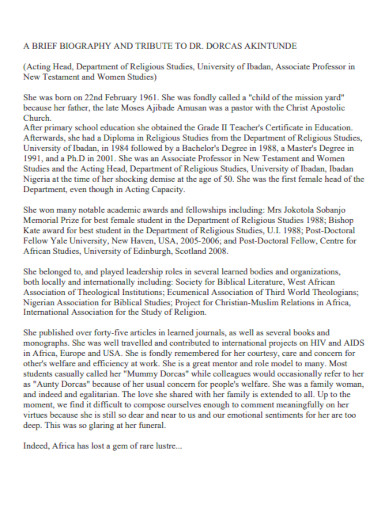
94. Mohandas Gandhi Biography
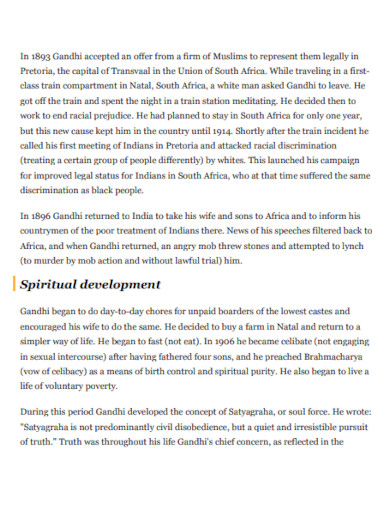
95. 30 Second Biography
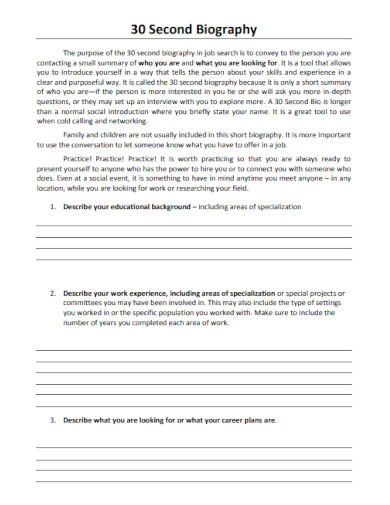
96. District Leader Biographical Information
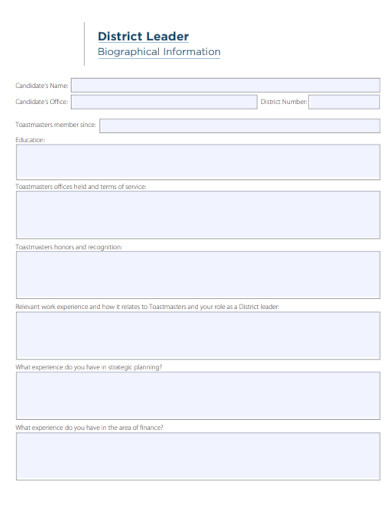
97. Indian Women Biography
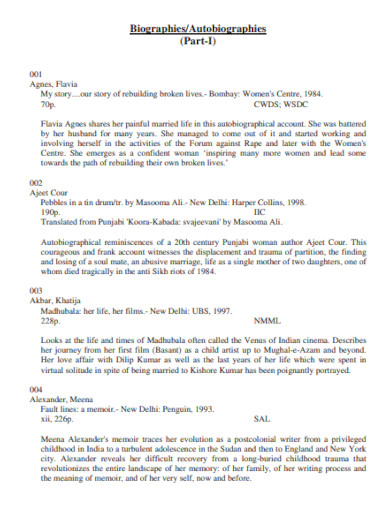
98. Autobiographies and Biographies
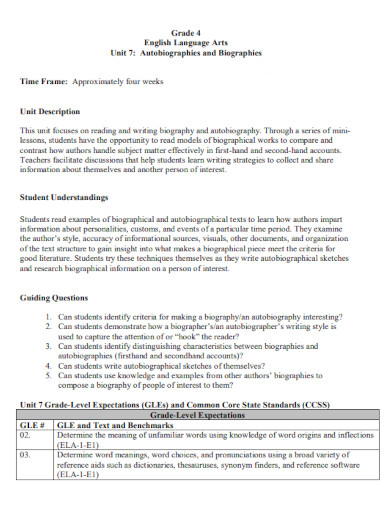
99. A Biography
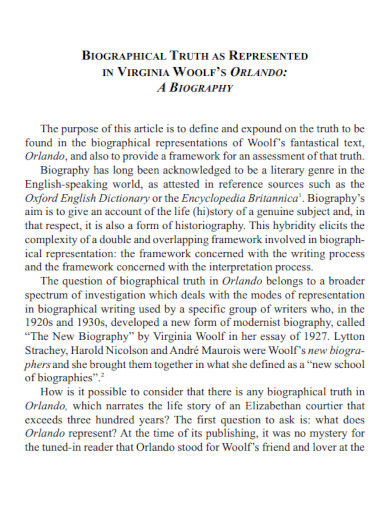
100. Biography in PDF

Different Aspects of Biography
Biographies encompass several dimensions that contribute to their depth and appeal. Understanding these aspects can enhance both the reading and writing of biographies, offering a more comprehensive view of the subject’s life.
Historical Context
This aspect involves placing the subject’s life within the broader historical period in which they lived. It includes the examination of social, political, and cultural events that influenced or were influenced by the subject.
Personal Background
This covers the subject’s family origins, upbringing, education, and early life experiences. It helps to understand the foundation upon which they built their achievements and character.
Career and Achievements
A critical focus is often on the subject’s professional life, including their career path, significant achievements, contributions to their field, and any obstacles they overcame along the way.
Psychological Dimension
Exploring the subject’s personality, motivations, values, and internal struggles offers insights into their actions and decisions. This aspect adds depth, showing the human behind the accomplishments.
Personal Relationships
The examination of key relationships in the subject’s life, including family, friends, mentors, and rivals, reveals how these interactions influenced their journey and development.
Impact and Legacy
Assessing the subject’s long-term impact on their field, community, or the world highlights their lasting legacy. This includes their influence on future generations, societal changes, or advancements in their area of expertise.
Controversies and Challenges
Addressing any controversies, criticisms, or significant challenges faced by the subject provides a balanced view of their life, showcasing resilience, perseverance, or, in some cases, their vulnerabilities.
Cultural and Social Contributions
This aspect looks at the subject’s contributions beyond their professional achievements, including their role in societal movements, cultural shifts, philanthropy, and public service.
How to Write a Biography
A well-written biography allows readers to have insight into the person’s life. Examples of well-written biographies include Steve Jobs a biography written by Walter Isaacson and Young Stalin by Simon Sebag Montefiore. If you are still confused about biographies and are still unsure about the whole writing process you may look at the biography examples, samples , and PDFs on the list above.
1.Obtain Permission from the Individual
Begin by obtaining permission from the individual you are writing about. Biographies can be made without the permission of the chosen individual, but having the permission of the individual will help provide more substantial information and gives you access to the thoughts of the chosen individual. Not only that, but their approval will also increase the chances of you being able to interview your chosen individual.
2.Research the Individual
Regardless if you have obtained the permission of the chosen individual, you will need to research the life of your subject. This means you must read articles, reports, and various articles all about the life of your subject. Not only must you read, but you must also interview people associated with and related to your subject’s life. Because of the factual nature of a biography , you must ensure that the data and information you are providing are factual, accurate, and credible.
3.Create a Timeline of Events
After you have completed your research, you will need to create a timeline of the events the subject has lived through. This will help create an outline and a reference that you can in your writing. Not only that but it will also help root out any inconsistencies in the information you have gathered or researched.
4.Write the Biography
Using the timeline, write down the biographical information of the person. Note that this step will be the longest and may take months or even years to accomplish.
5.Write Down Your Thoughts and Opinions.
After you have finished the biography properly, you can write down your thoughts and feelings about the biography to give it a bit of a personal flair and touch. This will help connect you to your target audience. When you have finished with everything, be sure to edit and revise the contents of the biography as you see fit.
What’s the Difference Between Biography and Autobiography?
A biography is a detailed account of a person’s life written by someone else, focusing on their achievements and impact. An autobiography is written by the subject themselves, offering a personal insight into their life experiences and perspectives.
What is the Meaning of the Term Biography?
Biography refers to a written account of another person’s life, detailing their experiences, accomplishments, and contributions to society. It aims to provide a comprehensive and insightful look into the subject’s life journey.
What is the Short Meaning of Biography?
A biography is a detailed written account of someone’s life, including their personal history, achievements, and impact on society, authored by another person.
Is a Biography a Life Story?
Yes, a biography is a life story, chronicling the significant events, achievements, and personal aspects of an individual’s life, written by someone other than the subject.
Is a Biography Written in First Person?
No, a biography is typically written in the third person, as it is authored by someone other than the subject, offering an external perspective on the individual’s life and achievements.
Biographies offer invaluable insights into individuals’ lives, showcasing their achievements, challenges, and legacies. They inspire, educate, and connect us to the broader tapestry of human experience and history.
AI Generator
Text prompt
- Instructive
- Professional
10 Examples of Public speaking
20 Examples of Gas lighting
Explore Jobs
- Jobs Near Me
- Remote Jobs
- Full Time Jobs
- Part Time Jobs
- Entry Level Jobs
- Work From Home Jobs
Find Specific Jobs
- $15 Per Hour Jobs
- $20 Per Hour Jobs
- Hiring Immediately Jobs
- High School Jobs
- H1b Visa Jobs
Explore Careers
- Business And Financial
- Architecture And Engineering
- Computer And Mathematical
Explore Professions
- What They Do
- Certifications
- Demographics
Best Companies
- Health Care
- Fortune 500
Explore Companies
- CEO And Executies
- Resume Builder
- Career Advice
- Explore Majors
- Questions And Answers
- Interview Questions
The Best Short Professional Bios (Examples + Templates)
- Resume Tips
- Best Resume Writing Services
- Things To Avoid On A Resume
- Resume Paper To Use
- What To Include In A Resume
- How To Write A Bio
- How To Write A Personal Statement
- Lied on Your Resume?
- Avoid Age Discrimination
- Words and Phrases You Shouldn't Include in Your Resume
- How Many Skills Should You List On A Resume
- Send A Resume As A Pdf
- Resume Critique
- Make A Resume Stand Out
- Resume Spelling
- Resume Past Or Present Tense
- How To List Projects On A resume
- Best Resume Action Words
- How To Quantify Your Resume
- Resume Bullet Points
- Are Resume Writers Worth It
- How Many Jobs To List On Resume
Summary. To write a short bio you should first make an initial introduction introducing yourself in the first or first person. Your short bio should include your brand, your accomplishments, and your values and goals. Your short bio should be one to three short paragraphs or four to eight sentences long.
Knowing how to write a concise, informative, and interesting biography about yourself can help throughout various parts of the professional process. You can use your bio to capture the attention of potential employers or clients and convince them to choose to employ or work with you.
In this article, you’ll learn more about what goes into a short bio and how to write one, and you’ll also get to see some short bio templates and examples to help you get an idea of what yours should look like.
Key Takeaways
A short bio serves to introduce you, your achievements, and what you offer professionally to potential employers or clients.
It’s important to keep your bio brief so that readers stay engaged and will remember your main points.
You may need to adjust your bio for different audiences, as your clients may want to know different information than a recruiter would.
Talk about your skills and accomplishments in your bio, but don’t exaggerate them.

What Is a Short Bio?
How to write a short bio, what to include in a short professional bio, short bio examples, short bio templates, tips for writing a short bio, writing a short bio faq.
- Sign Up For More Advice and Jobs
A short bio serves as your introduction to the professional world. In terms of finding or expanding on your job, a bio will cover your:
Work history
Achievements
Any other relevant professional information
Think of it as a professional memoir that a hiring manager or consumer can read and understand quickly. It’s usually about one to three paragraphs depending on experience.
There’s an emphasis on being succinct when it comes to writing a professional bio. This is because a bio is supposed to be a preface to attract recruiter attention and incline them to reach out for more information. Many readers will get lost or bored with a lengthy bio.
Using a short bio can be helpful across very different industries, from marketing to accounting, from psychiatry to sales.
You’re probably familiar with providing short bios on social media websites and applications. While the information and skills you include in a professional bio may differ, the general formatting is similar.
There’s a lot of considerations to take into account when writing a short bio, and it can quickly become intimidating. Deciding what information is relevant and how to keep it near 140 characters is no small task.
If you’re having difficulty writing a short bio, follow the outline below to craft an introduction that engages your reader.
Make an initial introduction. You can’t jump right into everything you’ve done and what you want to do in the future before introducing yourself.
Your bio’s first sentence should begin with your full name in the third person or introduce yourself in the first person and continue to briefly outline your most notable skills and accomplishments. It’s a good place to state your current job and employer.
Go deeper with what motivates you. Once you’ve catchily illustrated who you are in your short bio, you can use the second sentence to describe your motivations for your work.
Stating what drives you to do the work you do is essential to employers and customers alike. Whether you work as a physician or fitness consultant , there’s a reason why this is your profession, and you should explain that in your short professional bio.
Describe your accomplishments. Your short bio is for detailing why you’re the ideal candidate to be trusted with handling an employer or consumer’s business. By describing your prior accomplishments, you let them know what you could offer as an employee and how you’ve succeeded in the past.
While you should avoid sounding braggy, the reader is looking for information about what your qualifications are , and your accomplishments generally measure these qualities.
Even though you could probably go on for ages about the details of your accomplishments, save that for an interview . In a short bio, only include the most impressive of your achievements to outline.
Accomplishments relevant to a short bio could include:
Impressive results on a project
Former promotions
Awards received in your field
Certifications received
Include contact information. The purpose of a short bio as either a business or a job seeker is to inspire the reader to reach out. Without contact information, this pursuit becomes futile. Make sure your short bio has some way to contact you at the end.
Relevant contact information may include:
Phone number
Professional networking profile
A short professional bio includes:
Your full name. You can choose to write your bio in the first person (I, me, my) or third person (he, she, they), but either way, you need to include your full name at some point. Branding doesn’t work so well without a brand name (i.e., you!)
Your brand. Of course, if you have an actual brand that you’re trying to market, you should include the brand name as well.
What you do. Summarize what you want the reader to know about what you do in one sentence — tricky, we know.
Your accomplishments. For a short bio, you can stick with just one major accomplishment from your professional life. Or, if you have a string of impressive achievements, try condensing all of them down to one sentence.
Your goals and values. Let the reader know what makes you tick — why do you do what you do and what do you hope to achieve with your work? People are compelled by a story more than anything else, so it’s important to get this part right.
Something personal (optional). If you have a quirky tidbit about yourself you’d like to include, go for it. Just make sure it doesn’t throw off te the tone of the rest of your bio.
Contact info (optional). If your bio is serving as a call-to-action to drum up business or get leads on job opportunities, it makes sense to include your contact information at the end of your bio. It’s not necessary if that information is available elsewhere on the page , though.
Entry-Level Job-Seeker Bio Example
Mitchell Morrison is an upcoming video producer and editor who believes in the art of visual organization. He is a recent graduate from the University of Washington and focused on post-production during his time studying there. He was introduced to the magical world of visual art production by watching his father work on editing commercials growing up and has been working towards his dream of becoming a video editor ever since. During his last year of college, Mitchell participated in a competitive internship with Digital Space Films. He was chosen out of 2,000 applicants based on his academic portfolio and personal statement essay. This internship was an incredible learning experience and resulted in three professional accreditations for music video editing. Mitchell currently lives in Seattle, Washington pursuing freelance opportunities and spending time with his Dog, Pikachu. To get into contact with Mitchell: MitchellMorrisonVideo.com/contact
Working Professional Website Bio Example
Lisa Kennedy is an experienced real estate professional. She knows how important a home is for long-term happiness and has invested her career in putting people in the house they’ve always dreamed of. Lisa was driven to pursue real estate from her passion for helping people during life-altering times, and a keen interest in high-end, luxury homes. She’s been working in the real estate industry for ten years and in that time has assisted over 3,500 people in finding homes. She was educated at the University of Los Angeles with a bachelor’s in business management. She’s worked for some of the most respectable Real Estate companies in Los Angeles and individually under her agency “Kennedy Homes.” Lisa has also been published in Real Estate Quarterly Magazine as the 2017 winner of the “Top Luxury Home Seller” award. Lisa loves the culture of Los Angeles and has been living there with her family of five since she graduated from college. She enjoys spending her free time exploring towns along the West Coast and swimming. If you’d like to get in touch with Lisa: Email: [email protected]
Professional Networking Profile Bio Example
Bianca Jones Marketing Manager Miami, FL The first step towards customer satisfaction is being reached by stellar product marketing, and that’s what I aim to provide. My professional experience as a product marketing manager has allowed me to assist many organizations in improving their sales margins and audience response to emerging products. I’ve brought dedication and positive results to the companies I’ve worked for because I am passionate about product perception, marketing, and business statistics. What drives a product to success interests and inspires me. I specialize in long-term growth strategies and audience outreach. In addition to eight years of experience in professional product marketing, I have also published two books on creating a career as a marketer called “What to Do After Your Bachelor’s” and “A Marketer’s How-To.” If you’re interested in learning more about how to market your business better, or just discuss more, feel free to contact me by email at [email protected].
Your first choice is whether you want your bio to be written in the third person or first person. These short bio templates show both options, and also include different ideas for what to include, and how. Feel free to pick and choose your favorite parts of each of the two.
[Full Name] is a [job title] who [believes/knows] in the power of [what you do]. [He/She/They] began their journey in [field] by [how you got started in the field], and now dreams of [what you hope to accomplish]. [His/Her/Their] biggest accomplishment to date has been [your biggest accomplishment]. [Full Name] lives in [where you live] and participates in [a hobby/interest]. To get in touch with [Full Name], call/email/message me on [how you’d like to be contacted].
I am a [job title] who helps [who you help] [what you help them do]. It’s my belief that [your unique perspective on the field]. In the past [# of years] years, I’ve [major accomplishment #1] through [how you accomplished it]. I have a passion for [your professional passion], but on the side, I also enjoy [personal passion]. Get in touch with me today at [contact info] — I look forward to talking with you about [what you want to talk to your readers about].
You have a firm grasp of the structure of a short bio and what to include. Now, you may need some tips for how to polish your short professional bio and make it stand out from the competition.
Be mindful of length. While you’re probably getting sick of hearing that your bio should be short, it’s good to keep in mind throughout the writing process. It’s easy to go off on a tangent while trying to include everything relevant or rationalize, making your bio too long.
Avoid this impulse. The point of a bio is that it’s limited. You want to intrigue the reader enough to inspire them to seek more information about you or your services.
Tailor your bio to your intended audience. Whether you’re using a short bio to attract a particular customer base or potential employer, tailoring it to fit their wants and needs is crucial. Consider your intended audience base and what they’re looking for in a candidate or service.
Be genuine. Your short bio should be an authentic representation of your traits, experience, and personality. People are repelled by what they interpret as stretching the truth. If you’re being received as disingenuous by the reader, they’ll probably move on.
Proofread. The only way to steer clear of errors in your short bio is by proofreading it. Imagine a hiring manager being completely interested in your bio.
They love what you have to say about yourself and find your prior experience enticing. That is, until they come across a mistake that clearly shows you didn’t do proofread or edit.
Include links to your portfolio, website, or networking profile. One way to circumvent the confining factor of keeping your bio short is by including links to more detailed sources.
This can be in the form of linking your portfolio or website to allow the reader to go deeper into your discussed skills if they please, without taking up more space in your bio.
Implement these links seamlessly into your bio by attaching them to anchor words that describe what clicking will lead them to.
Add some personality. You aren’t the only person who has an impressive list of accomplishments to put on a bio, so you’re going to need to find some additional ways to make an impression.
What should a short bio include?
A short bio should include your name, what you do, and your achievements. You should also include your company or product’s brand, if you have one, and your goals and motivations for doing what you do. This humanizes you and helps you stand out from the rest of the pack.
How long is a short bio?
A short bio is typically one to three paragraphs long. These should be short paragraphs though, as other experts say that between four and eight sentences is the ideal length for a short bio.
What makes a good bio?
A good bio is succinct and memorable. Readers don’t want to spend long reading about your professional and personal life, so go back and cut it down to the important parts multiple times after you draft it. You might be surprised at how little you actually need to include.
What should you avoid putting in a short bio?
You should avoid including anything negative or arrogate. It’s never a good idea to write anything negative about previous jobs or employers. Only include positive things in your professional short bio.
It’s important to include your achievements in a short bio, but there is a fine line between mentioning your achievements and bragging about them. Stick to the facts when talking about your accomplishments.
Fremont University – Building Your Professional Bio
How useful was this post?
Click on a star to rate it!
Average rating / 5. Vote count:
No votes so far! Be the first to rate this post.

Sky Ariella is a professional freelance writer, originally from New York. She has been featured on websites and online magazines covering topics in career, travel, and lifestyle. She received her BA in psychology from Hunter College.
Don Pippin is an executive and HR leader for Fortune 50 and 500 companies and startups. In 2008, Don launched area|Talent with a focus on helping clients identify their brand. As a Certified Professional Resume Writer, Certified Digital Career Strategist, and Certified Personal Branding Strategist, Don guides clients through career transitions.
Recent Job Searches
- Registered Nurse Jobs Resume Location
- Truck Driver Jobs Resume Location
- Call Center Representative Jobs Resume Location
- Customer Service Representative Jobs Resume
- Delivery Driver Jobs Resume Location
- Warehouse Worker Jobs Resume Location
- Account Executive Jobs Resume Location
- Sales Associate Jobs Resume Location
- Licensed Practical Nurse Jobs Resume Location
- Company Driver Jobs Resume
Related posts

How To Write A College Freshman Resume (With Examples)
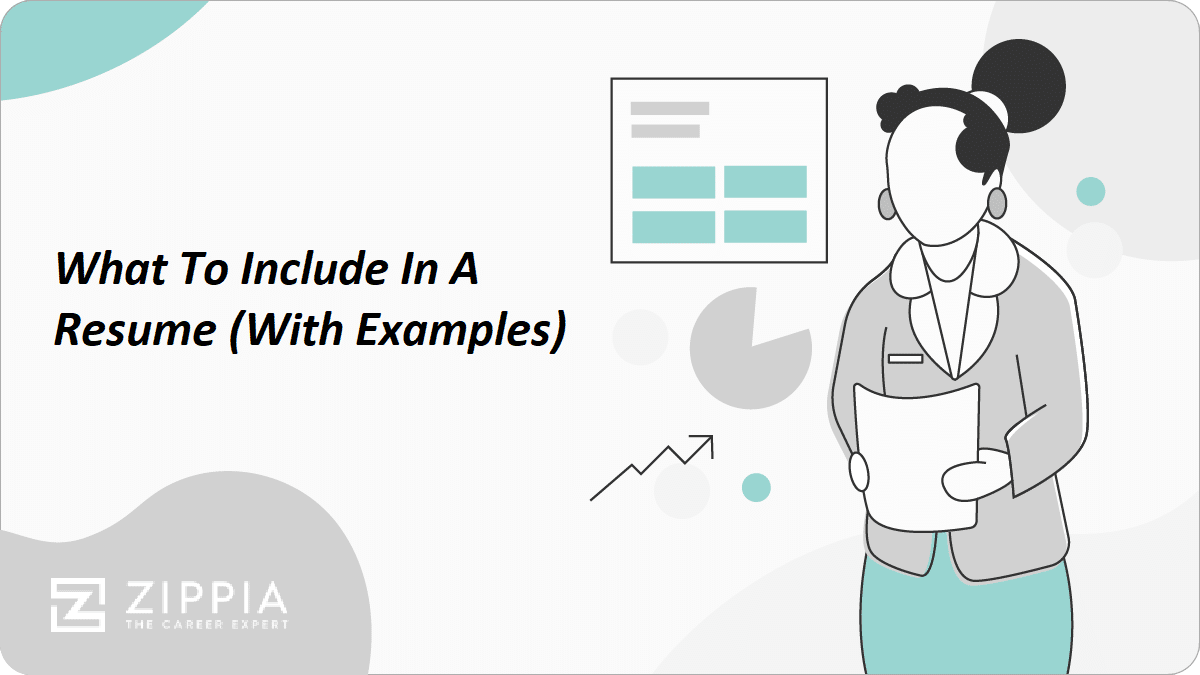
What To Include In A Resume (With Examples)

Military To Civilian Resume: How To Translate Your Military Skills

Resume Spelling: To Accent Or Not To Accent
- Career Advice >
Eat, Sleep, Wander
20+ Student Biography Examples
Welcome to the world of students! We have created an amazing collection of 30 student biography examples to help you write your own.
As a student, you are likely to be writing a variety of biographical pieces. Whether you are writing a personal profile for your CV, a biography for an awards application or a biography for a college admissions essay, it’s important that you construct an interesting and engaging narrative of who you are.

Student Biography Examples
1. Growing up I was always interested in the sciences and technology. In high school, I excelled in math and science classes, which led me to pursue a degree in engineering. I went on to earn my Bachelor’s degree in Engineering and am currently working on my Master’s in Civil Engineering. After I finish my degree, I plan to use my knowledge to help improve infrastructure in developing countries.
2. Since a young age, I have been passionate about helping people in need. During college, I decided to focus my studies on sociology and political science. I used my knowledge to take action and participated in several non-profit organizations to promote social justice. With the help of internships, I have also gained experience in policy development and public relations. I’m currently working on a graduate degree in Social Work and aim to eventually work for the United Nations .
3. As a freshman in high school, I was unsure of what kind of career path I wanted to pursue. After talking with my parents and teachers, I decided to start college as an undeclared major. After two years of exploration, I settled on a double major of business and economics. I’ve been able to take advantage of various opportunities on and off campus and served as an intern in the Human Resources department of a major banking firm. I look forward to earning my degree and using my skills to become a successful business leader.
4. I never thought that I had the ability to become a professional photographer, but my high school photography teacher pushed me to pursue my dreams. I learned how to use a variety of cameras, develop photographs, and post-process my images. I continued my photography studies at college, where I gained additional knowledge in studio lighting and digital editing. I was even able to gain experience in the fashion industry, interning for a well-known photographer . Today, I am working as an event photographer, documenting weddings, reunions, and corporate events.
5. When I was younger I was passionate about art, which prompted me to pursue a bachelor’s degree in Fine Arts. During college, I was able to gain experience as a studio assistant and also learn various digital and traditional art techniques. With the help of a scholarship, I was able to travel to various countries and learn even more about different art styles. After graduation, I started working as a freelance artist and have been able to produce several commissioned artworks and pieces.
6. As a child, I always exhibited an aptitude for mathematics and problem solving. After researching various career paths, I decided to major in Computer Science. I was able to gain valuable experience while interning at a tech startup and also during an internship with the Department of Defense. I am currently working on my master’s degree and plan to focus my studies on artificial intelligence and machine learning.
7. I have been involved in theater since I was a young child. During my high school years, I focused on honing my abilities through various extracurricular activities. I was able to gain valuable experience by participating in multiple productions and I even gained a scholarship for theater. I attended college to study Musical Theater and continued to foster my talent. With help from internships and workshops, I was able to build additional experience and formed a touring theater company with some of my colleagues.
8. From an early age, I was interested in the environment and the outdoors. I spent a lot of time reading environmental books and researching environmental issues. This passion inspired me to major in Environmental Science in college. I’ve gained valuable experience through various internships and part-time jobs. With the help of my degree, I’ve been able to work on several conservation projects and hope to soon work for a non-profit organization focused on sustainability.
9. When I graduated high school I wanted to focus my career on the medical field. After much research, I decided to major in Biomedical Engineering. During my time in college, I was able to gain a valuable experience by interning as a research assistant. I have been able to learn more about medical technology and have been able to contribute to various projects. I’m currently pursuing a master’s degree in Biomedical Engineering and plan to continue my research in the field and eventually work for a healthcare company.
10. I have always had an interest in fashion and design, so when the time came to decide my career path it made sense to pursue design. During college, I was able to study many aspects of fashion and gain experience through various internships. I was also able to travel to other countries to observe trends and learn about different cultures. With my degree, I am currently working as a fashion designer and I plan to continue to use my creative eye to come up with innovative and stylish designs.
More Student Biography Examples on the next page…
Become a Bestseller
Follow our 5-step publishing path.
Fundantals of Fiction & Story
Bring your story to life with a proven plan.
Market Your Book
Learn how to sell more copies.
Edit Your Book
Get professional editing support.
Author Advantage Accelerator Nonfiction
Grow your business, authority, and income.
Author Advantage Accelerator Fiction
Become a full-time fiction author.
Author Accelerator Elite
Take the fast-track to publishing success.
Take the Quiz
Let us pair you with the right fit.
Free Copy of Published.
Book title generator, nonfiction outline template, writing software quiz, book royalties calculator.
Learn how to write your book
Learn how to edit your book
Learn how to self-publish your book
Learn how to sell more books
Learn how to grow your business
Learn about self-help books
Learn about nonfiction writing
Learn about fiction writing
How to Get An ISBN Number
A Beginner’s Guide to Self-Publishing
How Much Do Self-Published Authors Make on Amazon?
Book Template: 9 Free Layouts
How to Write a Book in 12 Steps
The 15 Best Book Writing Software Tools
The Only (FREE) Autobiography Template You Need – 4 Simple Steps
POSTED ON Nov 22, 2023

Written by Shannon Clark
Are you looking for an autobiography template?
First things first.
What is your story? Not the shiny, air-brushed one you edit before posting on Instagram or the one you politely share during a writer’s chat on Zoom.
By your story, I mean the one with the cracks in it caused by childhood insecurities or the deep craters forged by unexpected collisions with life—the triumphs and tragedies that are forever etched into your DNA.
Yes, that story.
When you’re truly ready to write an autobiography, you’ll know it because you’ve come to a point in your life where the beauty of sharing your story has nothing to do with perfection. It’s knowing that despite the roller coaster ride that started at birth, you’ve found the courage to stay on it—sometimes holding on for dear life and other times riding with your hands up and screaming at the top of your lungs.
Get your autobiography template here:
Need A Nonfiction Book Outline?
You’ve lived thoroughly and learned to embrace who you’ve become in the process, scars and all.
This post will show you the format for writing an autobiography and the best way to package your story so you can provide the best reader experience possible.
This blog gives you a free autobiography template and more…
What is an autobiography.
The basic definition of an autobiography is that it’s a first-person account of your life. It differs from a memoir , which usually focuses on a single event or group of events that lead you to a discovery about yourself, your life, or some other revelation. An autobiography is a look at the total sum of your life from birth (early childhood) to the time of your book’s writing that highlights the key points that shaped who you’ve become.

Ready to start writing your autobiography? Let's get into it…
What is the format for an autobiography?
Just like any good story, every autobiography has a beginning, middle, and end. But before you begin filling in the sections, you want to come up with a theme for your book . Most people have too much life content to fit into one book. Selecting the parts that fit under the umbrella of a theme will make the book easier to follow.
When coming up with a theme, think about what you want the key takeaway to be for the reader. You don’t want to give them some boring slog through your life history. If you want them to feel something, your book needs direction. That’s where your theme takes the lead. By keeping it in the back of your mind while writing, you’ll give your readers a track to stay on. Otherwise, they may lose interest and stop reading.
Once you have your theme, right down the events in your life that are related to your book’s focus. You’ll plug these into the outline as you develop it.
Some examples of autobiography book themes are:
- Overcoming challenges
- Creating your own destiny
- The unbreakable bonds of family
- A faith journey
- Perseverance
Your theme can be whatever you want it to be, but keep your audience in mind when selecting one. Below you’ll find an autobiography template. It includes an outline with writing prompts in each section.
Whether you are an “outliner” (someone who outlines) or a “pantser” (someone who writes by the seat of their pants), the outline has enough structure and flexibility to make both writer types happy.
Autobiography Template: An Outline
I've laid out what a traditional autobiography might look like below. But to really help you get the most out of the blog post, I recommend downloading our nonfiction book outline to use alongside this guide.
1. Introduction
Before you share your life story, prepare your readers for what is to follow by introducing yourself and telling them what they can expect. You can cover some or all of the following:
- Why you are writing your autobiography?
- What do you hope the reader will take away from the experience?
- Any pertinent information that’s not covered in your book but that is needed for context.
2. The beginning – the early years
Since autobiographies are a condensed view of your life, you want to focus on the significant events that will move your story forward.
- Where do you want to begin your story?
- Where does your book’s theme first show up when you look back over your life? You want the opening of your book to have an impact, so choose something that will hook your readers and bring them into your world.
- How did your formative years influence how you viewed yourself? What we experience during our childhood can affect us for a lifetime. Consider how the early events of your life developed your character.
- Who influenced you the most during your childhood?
- What defining moments do you remember?
Where (on your timeline) and how you start your story is up to you. You want it to be something strong and significant to have the most impact on your reader. Here are the first few sentences of some autobiographies for inspiration .
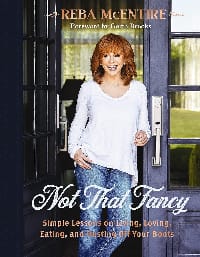
“Some would say the McEntires are a very set-in-their-ways, stubborn, hardheaded bunch of people. But I think that hardheadedness is what got Daddy to where he was, Grandpap to where he was, and his father, Pap, to where he was. Some might say it wasn't all that far- but it was much further than where they started!”
– Not That Fancy: Simple Lessons on Living, Loving, Eating, and Dusting Off Your Boots by Reba McEntire
(Nostalgia / Specific Event)
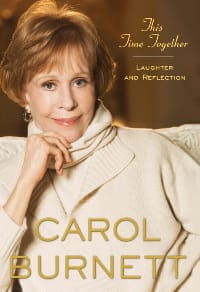
“My grandmother Nanny and I were at the picture show. I hadn't reached two digits yet in age because I distinctly remember my feet couldn't touch the floor of the movie house. Nanny and I were still living in San Antonio, Texas. My mama and daddy had gone ahead to California, where Nanny and I would later wind up.” – This Time Together: Laughter and Reflection by Carol Burnett
(From Birth)
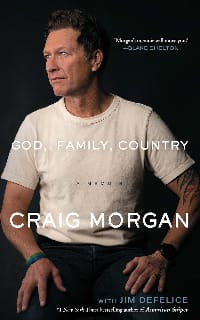
“ If you know my music, you almost certainly know me as Craig Morgan. But I was actually born Craig Morgan Greer. Craig Morgan came along many years later.” – God, Family, Country: A Memoir by Craig Morgan
- 31 Best Autobiographies
- 30 Celebrity Autobiographies
3. The middle- halfway between the early years and where you are today.
If you are using a timeline to divide your story, the period that you cover during the “middle” of your autobiography depends on how old you are at the writing of your book. If you are in your golden years, your midpoint might be in your 30s or 40s. For someone like Malala Yousafzai , who wrote her autobiography at age 15, her “middle” looked very different.
Whichever “middle” you choose consider the following:
- What are the defining moments during this time of your life?
- Did they change how you viewed yourself?
- Did they change the trajectory of what you initially thought you’d do with your life?
- Who had the most influence on your life during this time?
- What are some of the challenges you faced? How did you overcome them?
- Did your worldview change during this time? If so, in what ways?
If your “middle” doesn’t fit neatly into a timeline, consider grouping your autobiography into themed sections.
The autobiography Cash by Johnny Cash groups his story into sections based on places that had special meaning to him: Cinnamon Hill, The Road, Port Rickey, Bon Aqua, and The Road Again.
4. The end—wrap-up
The end of your autobiography is the climax. It’s what you’ve been leading your reader to since the first sentence of your book.
- Where are you in your life now? What have you learned? How has your journey impacted who you’ve become?
- How do you want the reader to feel when they read the last sentence of your book? Inspired? Hopeful? Full? Enlightened? Satisfied? All of the above?
- Is there any part of your life that feels unfinished or incomplete?
- Looking back over your life, what is the greatest lesson you learned?
- Don’t forget your audience, especially at the beginning of your book. You want to hook your readers early and bring them along for the ride.
- Write an eye-catching autobiography title for your book.
- Leave out the minutia. If it doesn’t move your story along, drop it.
- Tone matters. A good rule of thumb is to write your story like you were talking to a friend. Your story doesn’t have to be a monotone race to the finish line. Spice it up. Add some sparkle. Make sure your personality shines through.
- It’s always about the story. Buyers pick up your book to be entertained. Regardless of how serious your story is, it should be presented in a way that makes the reader want to keep turning the page.
- Every good story has a resolution. Good or bad, offer a resolution for each life conflict you introduce.
- As you share the final pieces of your story, use the end of your story to reflect on where you’ve been, what you’ve learned, and where you plan to go from there. Every relationship that ends can benefit from closure, and if the end of your story is not the end of your relationship with your reader, tell them where they can go to continue getting to know you.
Writing your autobiography is a courageous move, but who better to write your life story than you? If you have experiences that others will find interesting, share! You never know how your journey will impact someone else.
If you’re serious about getting your story published, Selfpublishing.com has a team of publishing experts who can walk you through the book development process.
FREE BOOK OUTLINE TEMPLATE
100% Customizable For Your Manuscript.
Related posts
Business, Non-Fiction
How to Get More Patients With a Book & Brand
Non-Fiction
How to Write a Biography: 10 Step Guide + Book Template
The 55 best biographies of all time.
All Formats
Outline Templates
Biography outline template – 10+ free word, excel, pdf format download.
Writing a biography is a difficult and challenging task. Digging up interesting and instructive facts of person’s life from the depths of forgotten histories and then trying to report it a narrative style which is attractive and appealing to a large section of readers can be quite taxing. For this very reason you should consider downloading one of our superb Autobiography Outline templates .

Albert Schweitzer Outline Biography Word Download
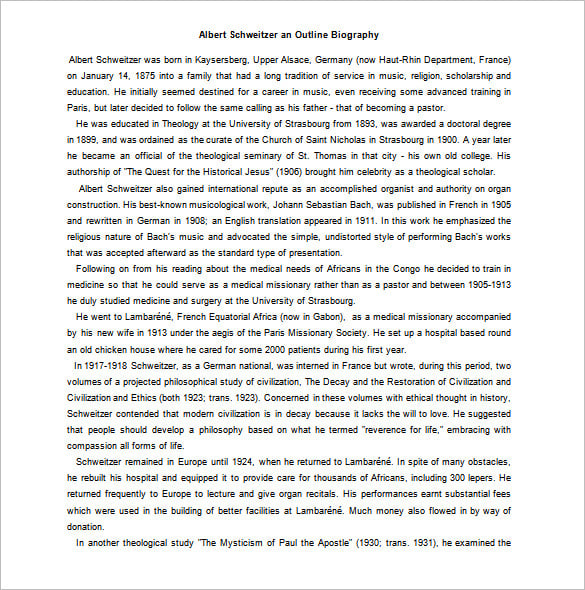
Free Download Biography Report Outline Template Word Doc

Free Biography Outline Template Instruction Download

Free Download Biography Outline Template Word Format
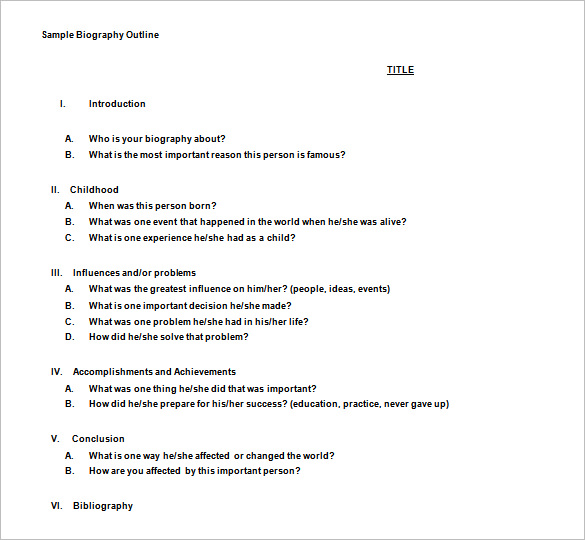
Write an Outline Biography
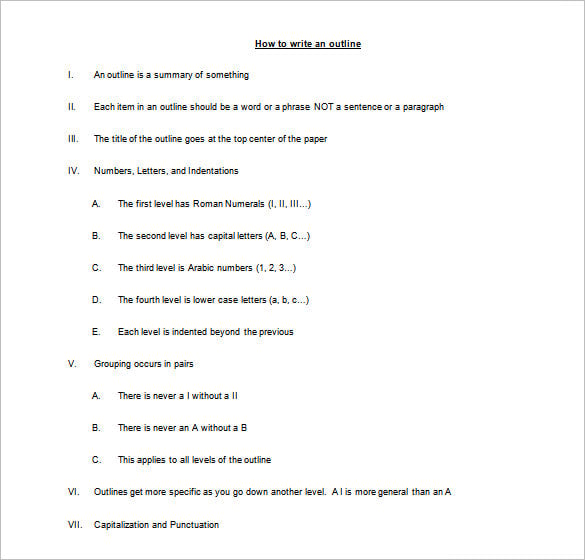
Biography outline Free MS Word Download
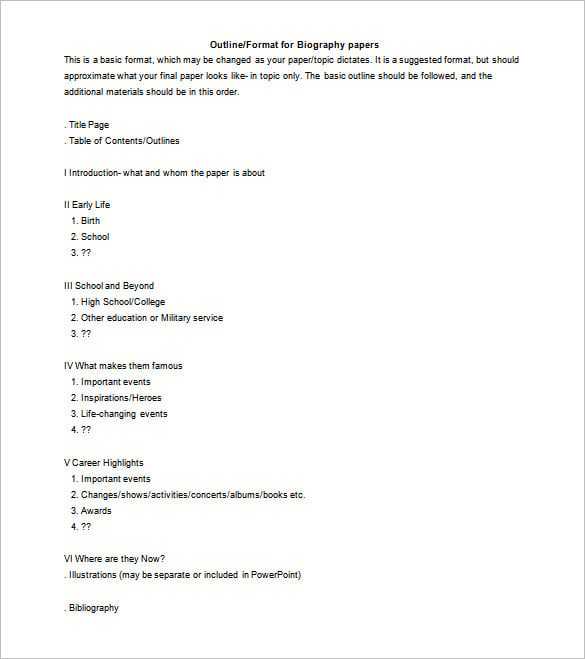
Fre Biography Essay Outline Template Download
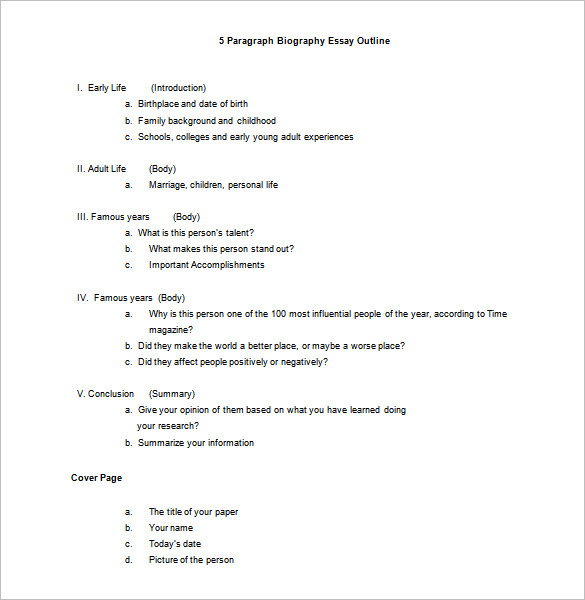
Blank Biography Report Outline Template Download PDF
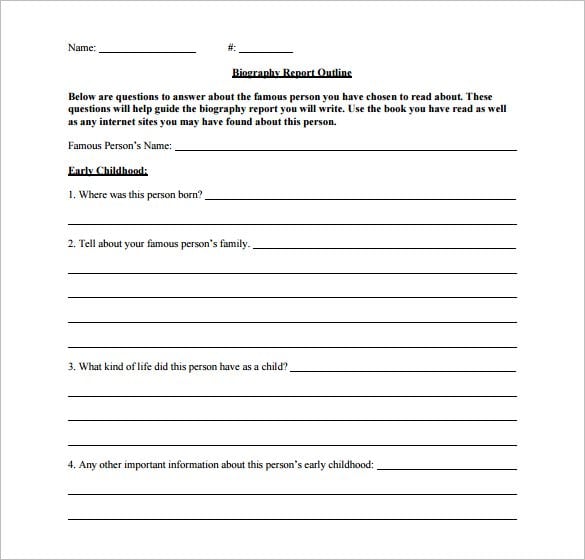
Biography Book Report Outline Template PDF Download
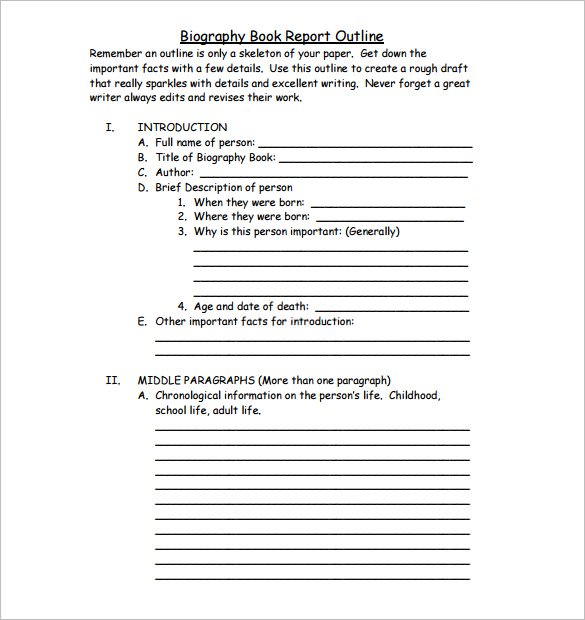
Recounting History as It Was: The Need for Biography Outlines
- These free outline templates will help you keep track of the timeline so that one portion of the biography does not take up the writing space of the other portions.
- They help you construct an easy visual of events that happened in the person’s life along with the chronology.
- Most importantly it checks on how you deal with the drama and conflicts and their resolution in the person’s life.
More in Outline Templates
Professional biography outline template, dentist biography template, writing a biography template, biography book report outline template, historical biography template, candidate biography template, biography essay template, aesthetic biography template, author biography template, autobiography ebook template.
- 10+ Training Outline Templates – PDF, Word, Apple Pages
- 24+ Autobiography Outline Templates & Samples – DOC, PDF
- 10+ Project Proposal Outline in Google Docs | MS Word | Pages | Editable PDF | InDesign | Photoshop | Publisher | PDF
- 12+ Literature Review Outline Templates – PDF, DOC
- 15+ Thesis Outline Templates – Sample, Example
- 11+ Outline Report Templates in Google Docs | Word | Pages | PDF
- 10+ Production Outline Templates
- 12+ Project Outline Templates in Google Docs | Word | Pages | PDF | XLS
- 15+ Meeting Outline Templates in PDF | DOC
- 8+ Project Proposal Outline Templates
- 12+ Outline Templates in Apple Pages
- 10+ Outline Templates in Word
- 10+ Outline Templates
- 15+ Topic Proposal Outline Templates – PDF, Word
- 12+ Research Project Proposal Outline Templates – PDF, Word, Pages
File Formats
Word templates, google docs templates, excel templates, powerpoint templates, google sheets templates, google slides templates, pdf templates, publisher templates, psd templates, indesign templates, illustrator templates, pages templates, keynote templates, numbers templates, outlook templates.

IMAGES
VIDEO
COMMENTS
A biography template has an outline that makes the writing easier for the author. Biography templates usually contain a sample timeline, format, and questions that provide more information about the subject. With a great biography template, you can cut your writing time in half and spend less time coming up with an outline.
Download Article. 1. Mention the person's name, birth date, and place of birth. Start by including key biographical details like the person's full name and their birth date. You can also provide the person's place of birth, especially if it will give readers context for the rest of the biography.
Biography Outline Templates & Examples. Biography refers to the historical information about a subject that is written by a person other than the subject himself. Like any other piece of writing, an outline is needed to do a better job. The outline basically provides the step-by-step guidance that is to be followed from scratch through to the ...
7. Get feedback and polish the text. If you're going to self-publish your biography, you'll have to polish it to professional standards. After leaving your work to rest for a while, look at it with fresh eyes and self-edit your manuscript eliminating passive voice, filler words, and redundant adverbs.
6. Make a timeline of a person's life. To help you organize your research, create a timeline of a person's entire life, from birth. Draw a long line on a piece of paper and sketch out as many details about a person's life as possible. Highlight important events or moments on the timeline.
Here are some examples of three types of individuals and the kind of research that will be most helpful. Historical Figures: When writing about historical figures, immerse yourself in their era. Understand the social, political, and cultural forces that shaped their lives. ... Outline your biography, ensuring a logical and engaging narrative ...
BIOGRAPHY WRITING Tip: #4 Put Something of Yourself into the Writing. While the defining feature of a biography is that it gives an account of a person's life, students must understand that this is not all a biography does. Relating the facts and details of a subject's life is not enough.
Personal Biography Template. A personal biography template is a structured outline designed to guide individuals in documenting their life stories, achievements, and experiences. It provides a framework to organize personal details in a coherent and engaging manner. This template, created in our prior response, can assist users by simplifying ...
8. Send a copy to your subject. Consider sending a copy of your manuscript to the person whose life you wrote about in your book. The copy may serve as a thank-you gift, but also, if you intend to publish your work, you will need them to approve, as well as fact check, everything you put into the story.
Step 1: Read other biographies. Step 2: Identify your subject. Step 3: Get permission to write about your subject. Step 4: Create an outline. Step 5: Select a working title (using a title generator) Step 6: Write a rough draft. Step 7: Self-edit. Step 8: Work with an editor.
A biography usually structures the main points of a person's life in chronological order. Knowing the order of key events before you start writing can save you the hassle of having to reorganize your whole story later. 5. Use flashbacks. While writing the text of your biography, you may want to intercut between an experience from your subject ...
2. Introduce yourself… like a real person. This is one of the most important pieces of understanding how to write a personal biography. Always start with your name. When many people start learning how to write a bio, they skip this important part. People need to know who you are before they learn what you do.
1. Go for a chronological structure. Start chronologically from the subject's birth to their death or later life. Use the timeline of the person's life to structure the biography. Start with birth and childhood. Then, go into young adulthood and adulthood.
2. Your Twitter bio. Even a snappy, 160-character bio can help set you apart. To write a great bio for social media, grab the first two sentences of the bio we just drafted. We've crammed a lot of great info in there: who you are, what you do, who you do it for, how you do it, and what you believe about the work you do.
A standard biography outline template sample is supposed to begin with a little foreword - or overview - about its subject. Then the focus shifts to details about his or her personality, family life, and a timeline of his life's high points - achievements, awards etc. Lastly the outline contains an author's note and an end note ...
Biography Outline Template - 15+ Formats, Samples and Examples. A Biography is a written account of one person's life written by someone else. Most biographies are written about people of notable interest, and people who have made an impression on society that has lasted, or will last, long after the end of that person's life.
Here are the main types: 1. Autobiography. Description: Written by the subject themselves, an autobiography is a self-narrated account of one's life. It provides personal insights and perspectives, offering a detailed look into the author's experiences, thoughts, and feelings. Focus: Personal journey, challenges, successes, and reflections. 2.
The Best Short Professional Bios (Examples + Templates) By Sky Ariella and Experts Feb. 5, 2023. Summary. To write a short bio you should first make an initial introduction introducing yourself in the first or first person. Your short bio should include your brand, your accomplishments, and your values and goals.
Here are some steps you can follow to help you write a successful short bio: 1. Choose a voice. The first step in writing a short bio is deciding on a voice. For our purposes, choosing a voice involves deciding whether you are writing in the first or third person. Writing in the first person means using the words "I" and "me", and writing in ...
Student Biography Examples. 1. Growing up I was always interested in the sciences and technology. In high school, I excelled in math and science classes, which led me to pursue a degree in engineering. I went on to earn my Bachelor's degree in Engineering and am currently working on my Master's in Civil Engineering.
3. Autobiography Template: An Outline. 4. Introduction. 5. The beginning - the early years. 6. The middle- halfway between the early years and where you are today. 7.
Recounting History as It Was: The Need for Biography Outlines. ... How to Make/Create an Essay Outline [Templates + Examples] 2023: 23+ Body Outline Templates - PDF, JPG: Speech Outline Template - 8+ Free Sample, Example, Format Download! 20+ Proposal Outline Templates - DOC, PDF: